Maine, also known as the Pine Tree State, promotes a friendly environment for birds. With almost 89% of its area covered with forest, there’s plenty of food, water, and shelter for birds. But, what birds can you expect to see in Maine? Which ones are the most common backyard birds of Maine?
Well, Maine is home to A LOT of birds. In fact…
Maine is home for hundreds and hundreds of different bird species and there are approximately 290 native bird or regular visitors.
So, if we’re going to talk about them one by one, it’s going to take days. That’s why we took a survey and asked 188 Maine bird watchers what birds they commonly see around the area. Here are our results:
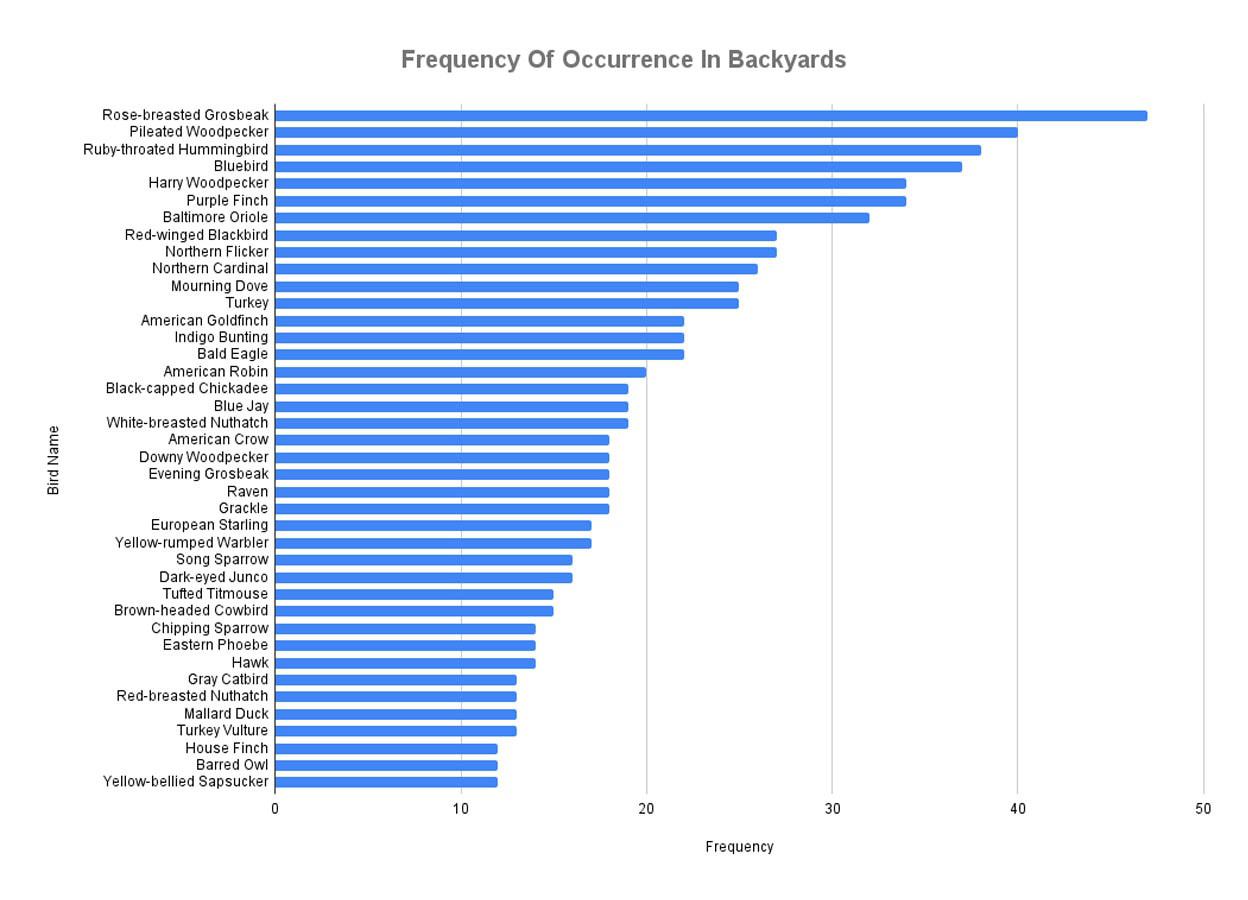
Based on that survey, I made a list of the 40 most common backyard birds you’ll find in Maine. I’m also going to share information about the birds, such as their:
- Identification
- Common Habitat
- Behavior
- Where they’re commonly found in Maine
So, if you’re moving or planning to visit Maine soon, below are the birds you’re most likely going to see…
1. Rose-breasted Grosbeak (46% Frequency)
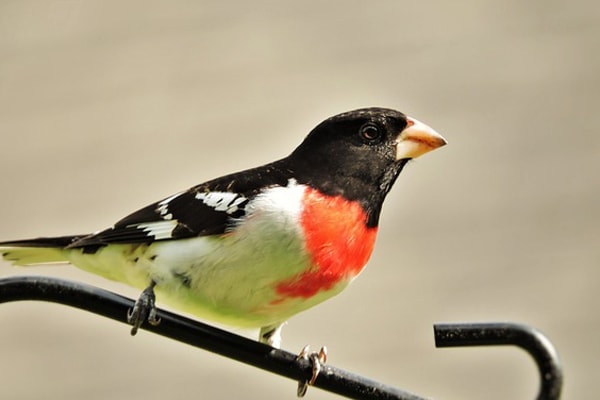
Right at the top of our list, with 46% frequency, is the Rose-breasted Grosbeak.
These birds are seen all around Maine during the breeding season. They are medium-sized birds with a length of 7.1 to 8.3 inches and weigh around 1.4 to 1.7 ounces.
Male birds are easily identified with their black-and-white color and a beautifully distinct red patch on their chest. However, when they open their wings, you’ll also see a flash of a bright red color under.
Females, on the other hand, wear brown-colored feathers and are heavily streaked. You can also see that they have a distinct white stripe on top of their eyes, and their underwings are yellowish instead of bright red.
Rose-breasted Grosbeaks eat a variety of insects, seeds, and fruits. Their diet only varies depending on the food supply available. During the breeding season, when insects are abundant, they mostly eat insects, while during winter, they opt for seeds or fruits available.
These birds breed in open deciduous or mixed forests, preferring to stay in forest edges than in the forest center. They can also be found in parks, suburbs, gardens, orchards, and other areas near water sources.
In Maine, you’ll greatly appreciate the color these birds give in your backyard. But when migration time comes, they leave. These birds are long-distance migrants, which means they migrate further down south for winter, sometimes reaching parts of northern South America.
These birds often stop by various forests, urban areas, pine woods, and even wetlands during migration.
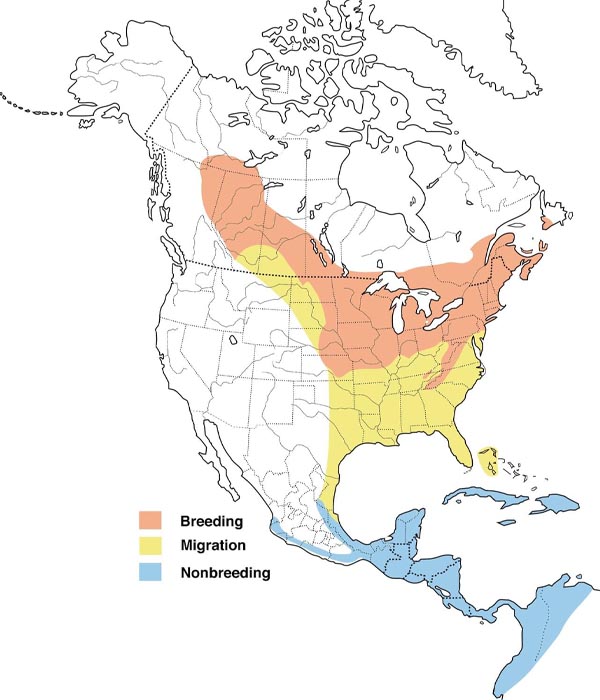
2. Pileated Woodpecker (40% Frequency)
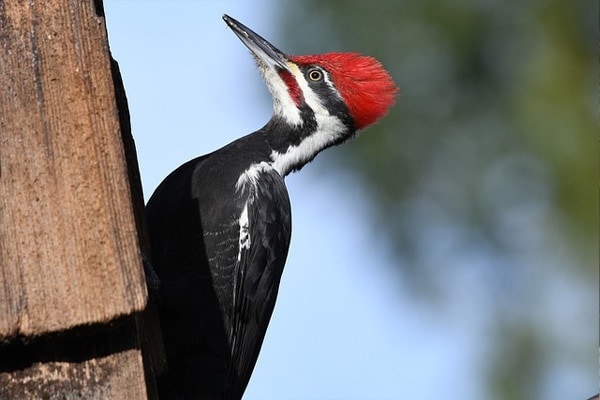
Next on our list, with 40% frequency, is the Pileated Woodpecker, which is the largest woodpecker you’d find in Maine.
These birds can grow at a length of 15.8 to 19.3 inches and weigh around 8.8 to 12.3 ounces. So, you’ll definitely stop on your tracks once you see them in trees around Maine.
The birds feature a long neck and a red-orange crest on top of their heads. They are covered in black feathers with a few white stripes on their face and neck. In-flight, Pileated Woodpeckers reveal some white underwings. Males also have a red stripe on their cheeks that are missing on the females.
Pileated Woodpeckers are common in large and mature forests, usually in deciduous or mixed woodlands with many fallen or dead trees. So, if you want to see these birds, going to these parts of the state would be your best option.
These birds mainly rely on food hidden on dead wood. This includes carpenter ants, termites, and wood-boring beetles. However, they also eat other insects like caterpillars, cockroaches, and grasshoppers, and wild fruits like blackberries, poison ivies, and elderberries.
As these birds are nonmigratory, they rely on bird feeders during winter to eat seeds and suet.
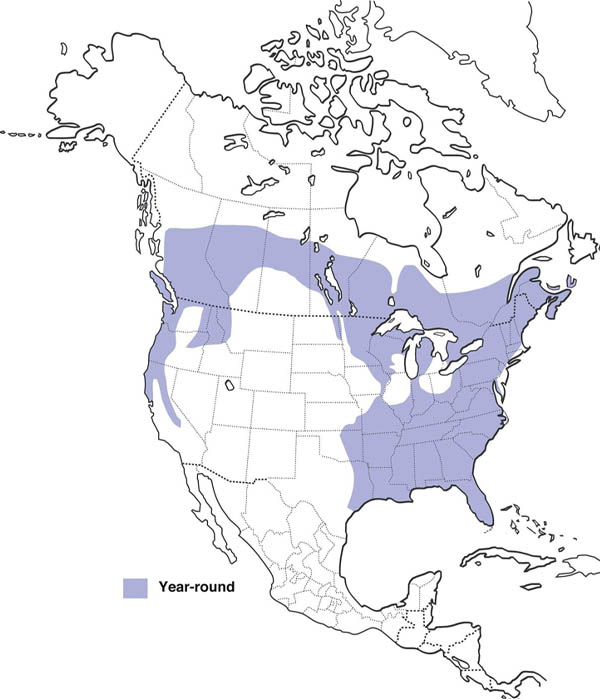
3. Ruby-throated Hummingbird (37% Frequency)
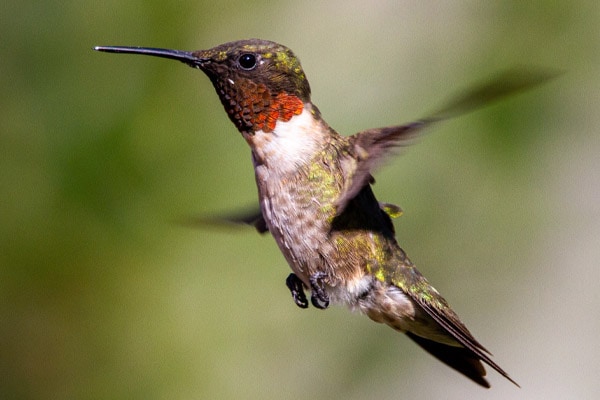
With 37% frequency, the Ruby-throated Hummingbird comes third.
It is a beautiful bird that breeds in the eastern parts of the US, including Maine. They are medium to long-distance migratory birds that travel to Central America and Mexico for winter.
These are very small birds that grow at a length of 2.8 to 3.5 inches and weigh around 0.1 to 0.2 ounces. They feature a bright green or golden green-colored back and head, gray-white-colored under areas, and a beautiful red throat when shown in the light.
Male and female Ruby-throated Hummingbirds don’t look similar. Females are plainer and duller with their grayish-black back and head areas and white underparts.
They arrive in Maine around Spring for the breeding season and usually stay in old fields, orchards, forest edges, woodlands, and backyards. They would then feed on nectars of red or orange flowers as their main food source.
These birds are known for being great flyers. They can flap their wings so fast that it would seem like they’re hovering midair.
If you wish to attract these beautiful birds, hanging some red or orange hummingbird feeders would be your best option.
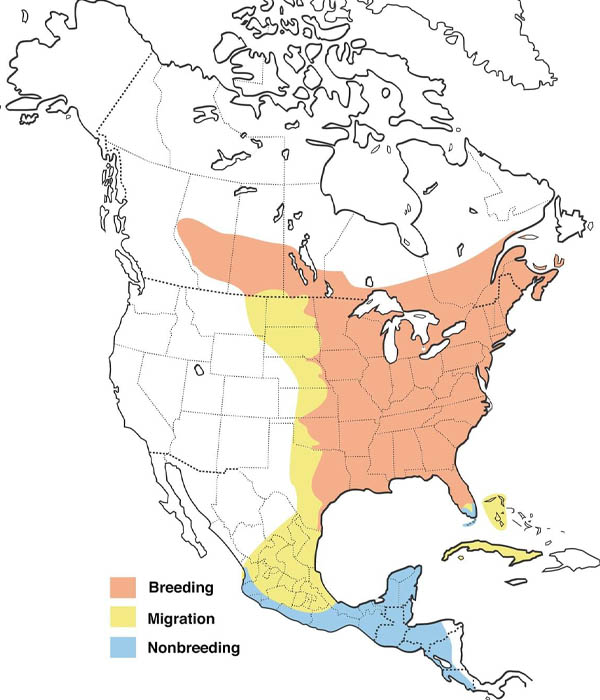
4. Eastern Bluebird (36% Frequency)
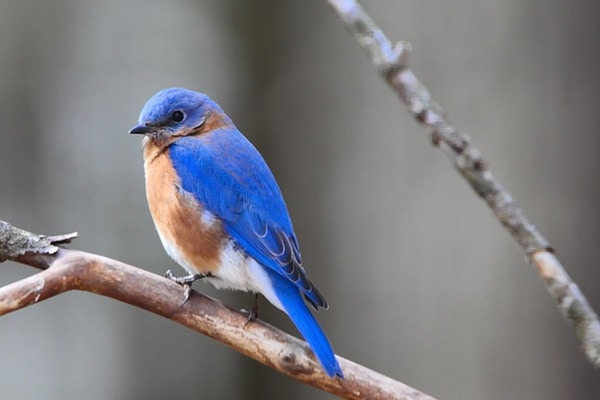
Right below Ruby-throated Hummingbird is the Eastern Bluebird that has a 36% frequency of occurrence in backyards.
The Eastern Bluebird is a beautiful bird that caught lots of people’s attention. Thanks to their beautiful blue plumage and cheerful qualities.
They grow at a length of 6.3 to 8.3 inches and weigh around 1.0 to 1.1 ounces. They feature a bright blue-colored back and head, a brick-red-colored breast, and white under areas. Females are pale with their grayish head and back areas, orange-brown breast, and white under areas.
These birds are the only blue birds you’ll find in the state, and you’ll commonly see them in open areas like meadows, fields, cemeteries, parks, and backyards.
They were once endangered due to a lack of availability in nest sites. But thankfully, due to the efforts of people to provide nest boxes, the Eastern Bluebirds’ population grew.
Eastern Bluebirds are resident to medium-distance migratory birds. They stay in Maine throughout the breeding season but move down south to Mexico or the southeastern parts of the US for winter.
If you want to attract them to your backyards during summer, make sure to provide them food, water, and shelter. These birds love mealworms and berries the most.
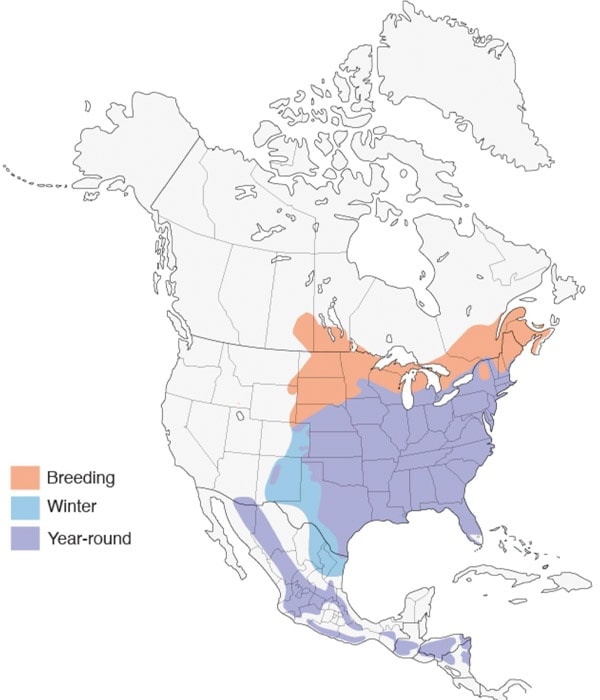
5. Hairy Woodpecker (34% Frequency)
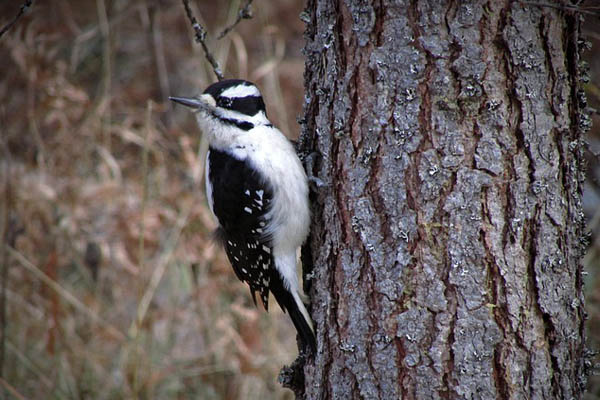
The Hairy Woodpecker, with 34% frequency of occurrence, is another popular woodpecker found in Maine.
These birds look almost similar to the Downies but are larger. They grow at a length of 7.1 to 10.2 inches and weigh around 1.4 to 3.4 ounces. They are also characterized by a black and white color pattern with white spots on their wings. However, compared to the Downies, they don’t have black spots on their tails.
Hairy Woodpeckers are found all year round in the state. They are generally found anywhere where there are large trees. This could be in mature forests, backyards, parks, orchards, suburbs, orchards, and cemeteries.
Although very common in the state, Hairy Woodpeckers are actually lesser in number than the Downies.
Around 75 percent of the bird’s diet consists of insects. So they would usually search for food on tree barks like ants, wood-boring beetles, moth pupae, and bark beetles. But they are frequent visitors of bird feeders, too, especially in winter and there’s suet available.
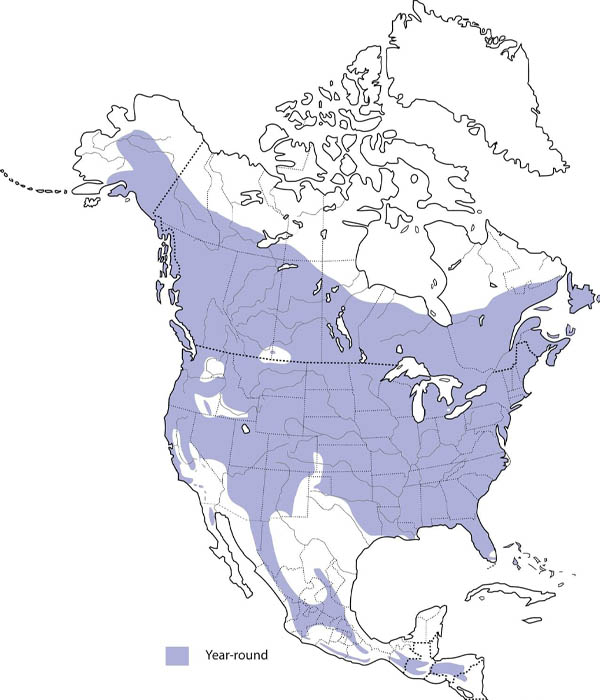
6. Purple Finch (34% Frequency)
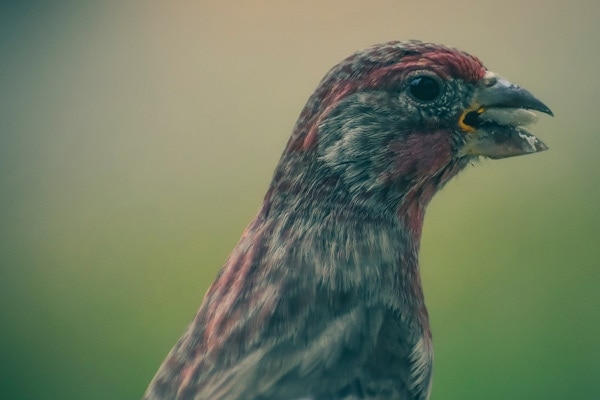
Another popular bird in the state is the Purple Finch, which has a 34% frequency of occurrence in the backyard.
Although Purple Finches have the word “purple” on their name, they are not colored purple. Instead, the male birds wear pink-red colored feathers on their head and breasts. Females, on the other hand, don’t have any hint of red. Instead, they are brown-colored, heavily streaked, and have a very clean face.
These birds are seen only in Maine all year round.
They mainly breed in evergreen forests but are also found in mixed forests, suburbs, and trees along water sources. However, they are more widespread during winter and are found in forests, backyard feeders, fields, and hedgerows.
These birds love seeds, berries, and fruit. So, if they visit your bird feeders, make sure that you have many bird seeds to offer and plant some berries around. Make your yard insect-friendly, too, as these birds need insects during the breeding season.
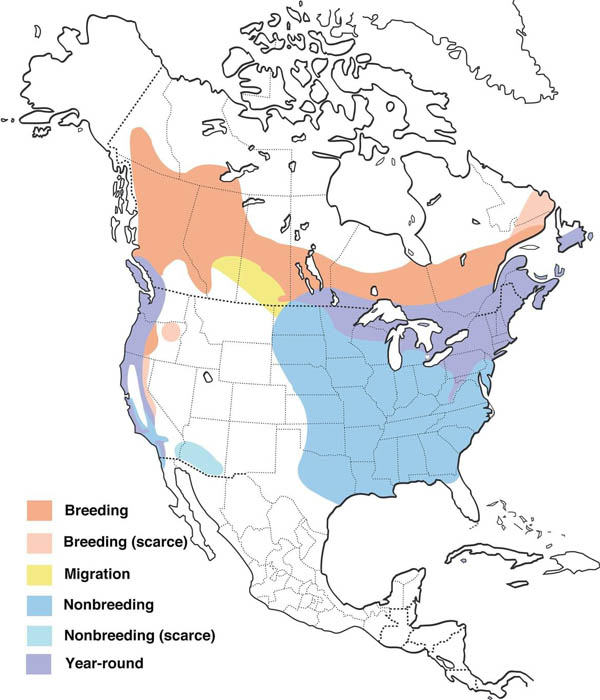
7. Baltimore Oriole (32% Frequency)
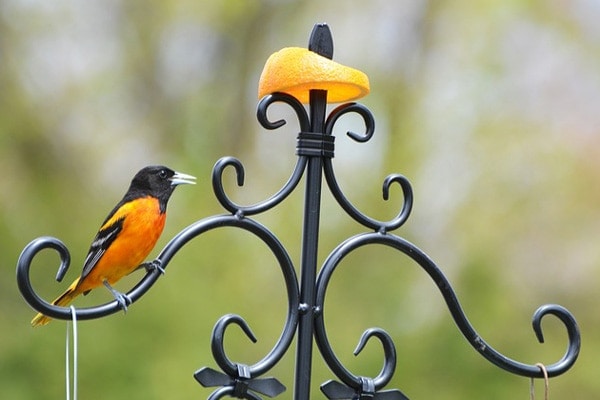
The Baltimore Oriole is another beautiful bird you’ll commonly find in Maine and, according to our survey, has 32% frequency.
They’re one of the first birds to arrive in spring, and people love having them in their backyards because of the color they bring.
These birds grow at a length of 6.7 to 7.5 inches and weigh around 1.1 to 1.4 ounces. Male Baltimore Orioles feature beautiful bright orange and black-colored bodies with a full black-colored head. There’s also a noticeable white bar on their black wings.
Females, on the other hand, are not as bright as males. They feature a lighter yellow-orange color on their bodies, yellow head, and brownish wings with white bars.
These birds are commonly found in forest edges, along the river banks, and small groves. They find habitats high up in leafy deciduous trees.
When looking for food, they usually visit backyard feeders but not for the bird seeds. Instead, they are more interested in eating ripe fruit, jelly, and nectar that help provide them energy. They also eat insects, so making your yard insect-friendly is essential if you wish to attract these birds.
The birds leave Maine to fly to their wintering ground around autumn, so you most likely won’t see their colorful feathers in winter.
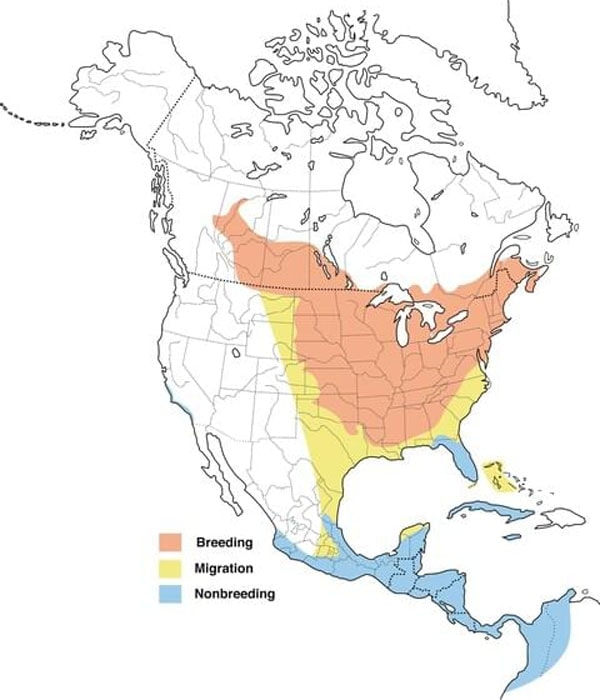
8. Red-winged Blackbird (27% Frequency)
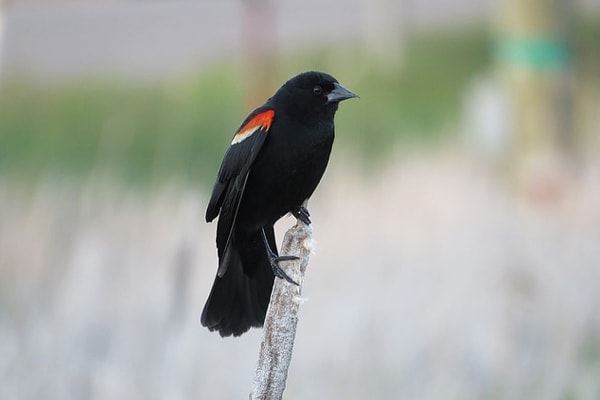
The Red-winged Blackbird is a beautiful bird commonly found around Maine during the breeding season, which begins around spring until mid-summer. They show up in the backyard with 37% frequency.
These are medium-sized birds that grow at a length of 6.7 to 9.1 inches and weigh around 1.1 to 2.7 ounces. Male Red-winged Blackbirds are covered in all black feathers with two noticeable red patches on their wings (thus, the name). On the other hand, female Red-winged Blackbirds look very distinct from the males with their overall brown color on their back and yellowish-brown head.
During the winter season, the birds change color, showing a scaly appearance without any red patches. But, you can no longer witness this because they usually fly down south for winter.
As these birds are present in Maine during their breeding season, you’ll commonly see them in wet places like marshes, swamps, meadows, rice paddies, and pastures. There are also times when you’ll find them nesting in forests but always near water sources.
However, once the breeding season is over, they fly down south and mainly stay in grasslands, farms, and fields.
These birds tend to socialize with other bird species during winter, like starlings, grackles, and cowbirds.
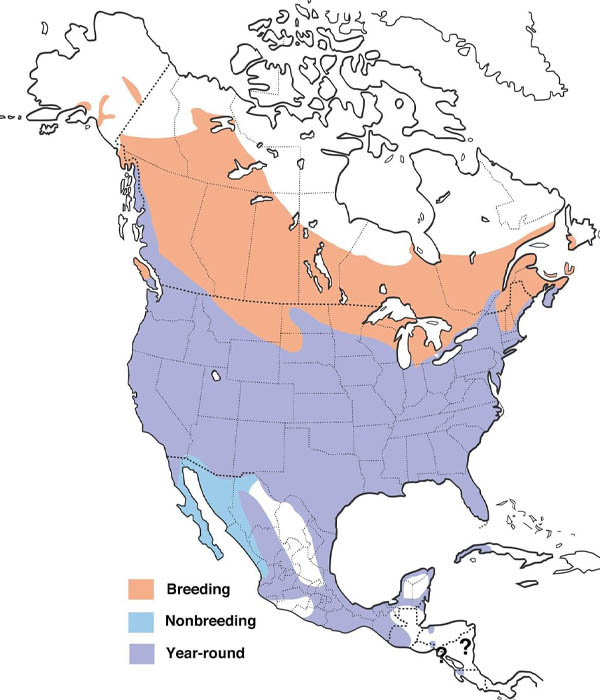
9. Northern Flicker (27% Frequency)
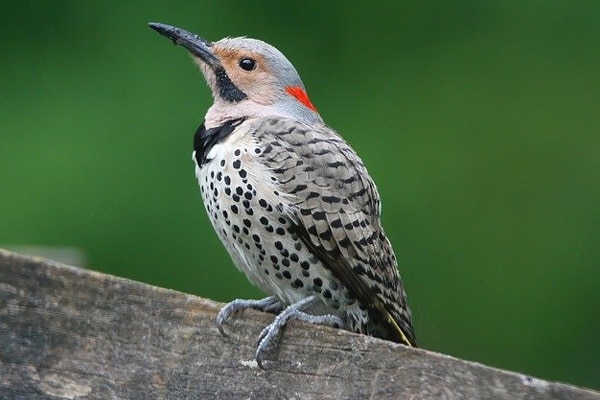
Also with a 27% frequency of occurrence, Northern Flicker is another common bird found in the backyards of Maine.
Despite not being named one, the Northern Flicker is a woodpecker. These birds grow at a length of 11.0 to 12.2 inches and weigh around 3.9 to 5.6 ounces. So, they are a bit smaller than the Pileated Woodpecker.
These birds are quite colorful. These birds may look gray from a distance with very bold black dots. They have a black crescent mark on their chest, an identifiable stripe on their cheeks, and a brown line between their eyes and beaks.
When the birds spread their wings, you’ll notice a brownish-black color with distinct bars. Their tail comes with a white patch, but the ends have the same pattern as the wings. Their underwings show different colors depending on the area: bright yellow for birds from the east and red for birds from the west.
The Northern Flicker is found in Maine during the breeding season. They are short-distance migrants and would often move south for winter, sometimes reaching Mexico.
You can see them in various habitats, including woodlands, edges of forests, fields, parks, and suburbs. They are also frequent in areas near water sources.
Although woodpeckers, these birds mainly forage on the ground instead of searching for food in tree barks. They also perch in thin branches instead of tree trunks like other woodpeckers.
Their diet may also be different as they prefer insects mostly found on the ground like ants. And instead of hammering on trees, the birds mainly hammer on the ground.
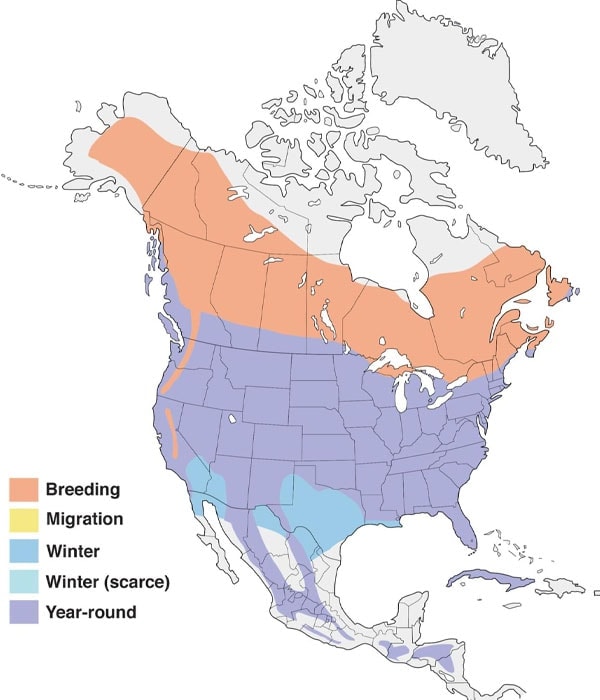
10. Northern Cardinal (26% Frequency)
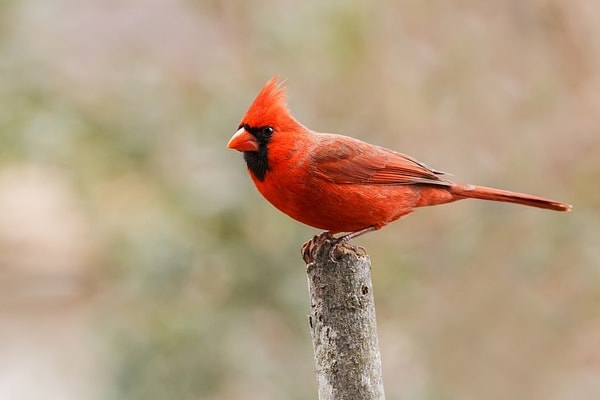
The Northern Cardinal bird is another beautiful bird found commonly in the eastern part of the US, including Maine. These birds are known for their beautiful red color that colors the backyard every summer and is found in Maine at 26% frequency.
These birds grow at a length of 8.3 to 9.1 inches and weigh around 1.5 to 1.7 ounces. Male birds wear red feathers all over their bodies, while females show a pale yellow color.
The birds also feature a heavy, orange bill and a distinct crest, which earned them their name.
Cardinals are commonly found in dense, shrubby areas like forest edges, fields, ornamental landscapes, and thickets. They are also frequent visitors of backyard bird feeders. So, if you wish to give your backyard some color, try to fill some bird feeders with sunflower seeds, safflower seeds, peanuts, and corn.
These birds are also easier to attract if you’re going to use tray or hopper feeders because cardinals would most prefer feeders where they can cling.
Northern Cardinals are also one of the most sociable birds you’ll see. During the breeding season, you might see them in pairs. But once winter comes, these birds have no problems with socializing and foraging with other bird species.
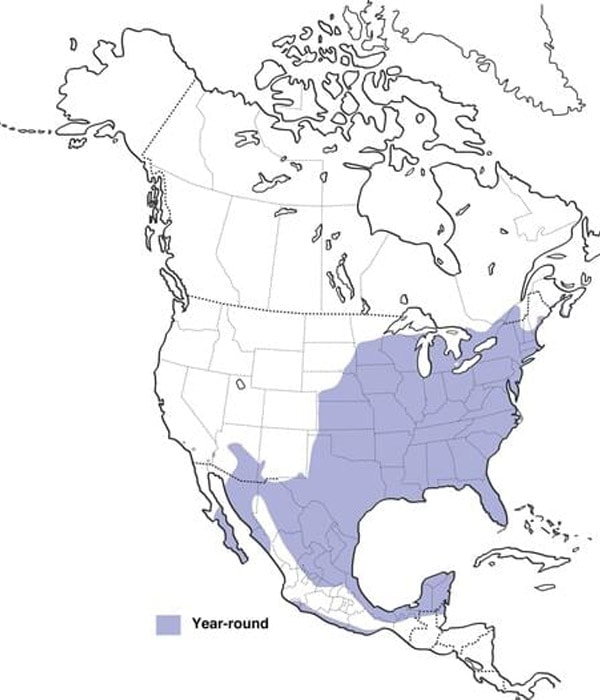
11. Mourning Dove (25% Frequency)
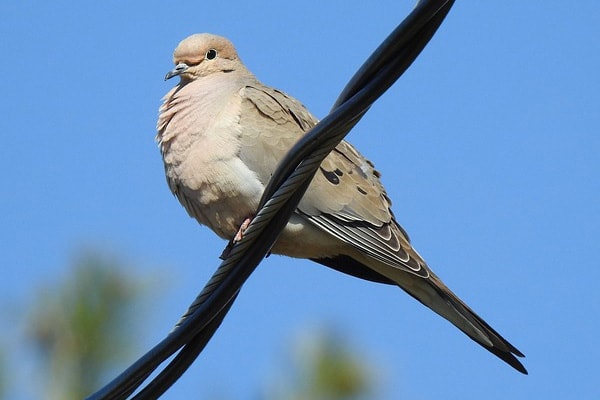
The Mourning Dove is the most common dove found in Maine, with an occurrence of 25% frequency. These are medium-sized birds that grow in a length of 9.1 to 13.4 inches and weigh around 3.4 to 6.0 ounces.
The birds are easily identifiable with their plump bodies that come in brown or tan color. You’ll also notice that they have black spots on their wings and black tails with white borders.
These birds are easily seen anywhere. Look up high, and you’ll see them perched high on a tree or wires. Sometimes they are also on the ground when feeding on grasslands, fields, backyards, and roadsides.
Around 99 percent of the bird’s diet consists of seeds. And since they are common visitors of bird feeders, it’s best if you prepare some of their favorite foods like millet, nyjer seeds, sunflower seeds, safflower seeds, and cracked corn.
You’ll find the Mourning Doves all year round in Maine. So, make sure to provide them food for the breeding and winter season.
If you can’t find a Mourning Dove around you, then maybe you’ll hear them.
These birds have a very distinct sound and can be heard near windows early in the morning. Their tune is almost similar to that of an owl because of their low “coo” sounds.
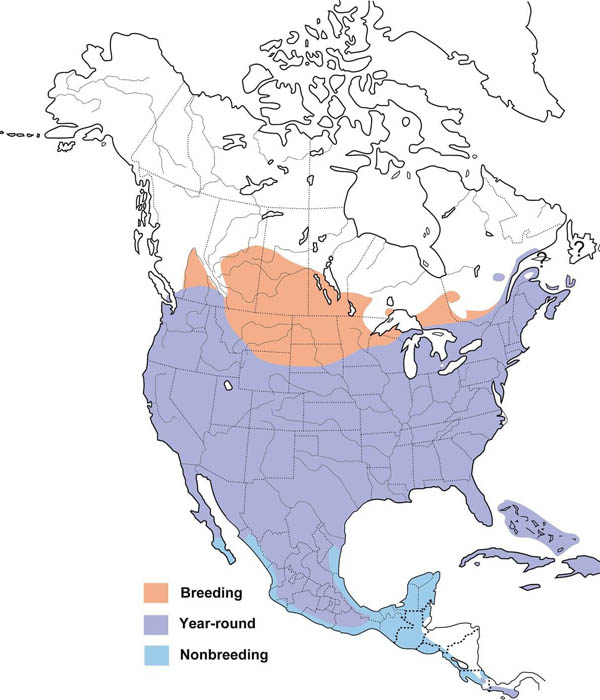
12. Turkey (25% Frequency)

With 25% frequency, the next bird on our list is Wild Turkey.
Unlike Domestic Turkeys, these birds can fly short distances at a speed of 40-50mph. And they can also scarily run fast at 12 mph.
These birds are probably the largest on this list. They grow at a length of 43.3 to 45.3 inches and weigh around 88.2 to 381 ounces. They feature an overall dark color with a brown to green iridescence. Their wings are black with white bars, their necks are red, and they feature a bald grayish-red head.
They’re probably a few of those birds you would most likely think of as frequent backyard visitors.
Wild Turkeys are found in only a few countries of Maine, mainly in the southern part. The birds are also known for being residential, and they stay all year round in most parts of the United States.
These birds were introduced in Maine around 1977, and there were struggles in keeping their numbers up. There were many times when the population drastically decreased, but now, it has been pretty stable.
The birds live in a variety of habitats, whether it’s in forests or open fields. They are also pretty common in suburban areas.
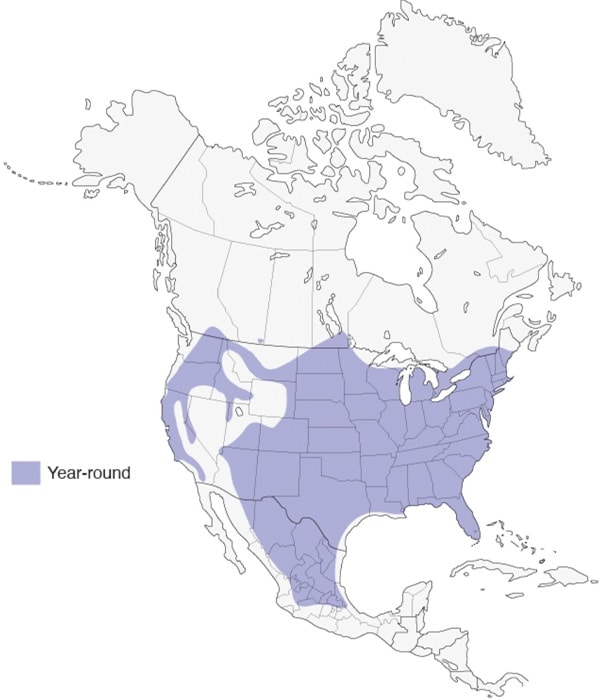
13. American Goldfinch (22% Frequency)
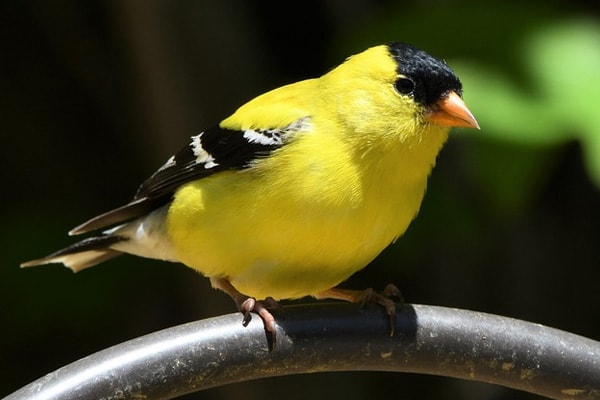
The American Goldfinch has a 22% frequency of occurrence in backyards. It is a small-sized bird that grows about 4.3 to 5.1 inches in length and weighs around 0.4 to 0.7 ounces.
Male and female American Goldfinches don’t look the same. The male birds wear the bright yellow plumage, while females are seen to have an olive to yellow plumage. However, when winter comes, both birds almost look identical as males experience molting.
These birds are widespread and seen year-round in the state of Maine. They are frequent bird feeder visitors who particularly love Nyjer seeds and sunflower kernels.
As they are tiny birds, American Goldfinches are easily bullied by larger bird species. So, if you’re planning to attract one in your backyard, it’s best that they have their own bird feeder that only they can use.
Besides your backyard, you can also enjoy seeing American Goldfinches in open fields, parks, and other areas with plants where they can eat and seek shelter.
These birds breed late in summer, mainly because food is more abundant around this time. It’s when most weeds appear and seed, especially thistles, which are the birds’ favorite.
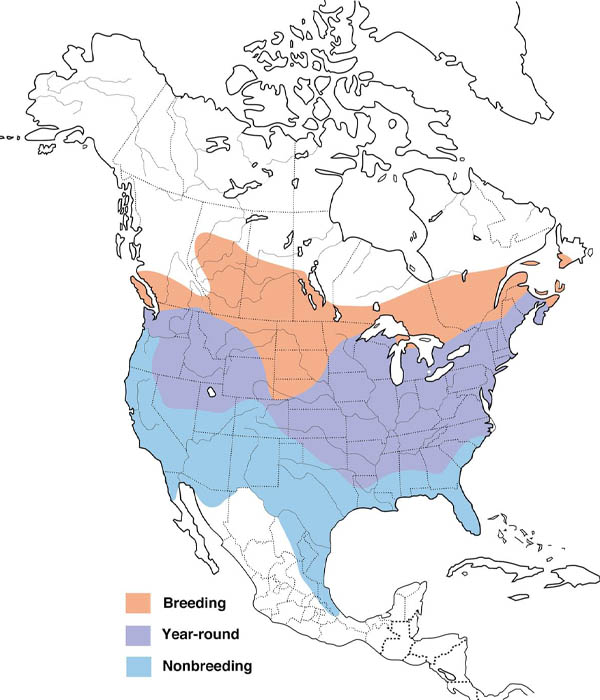
14. Indigo Bunting (22% Frequency)
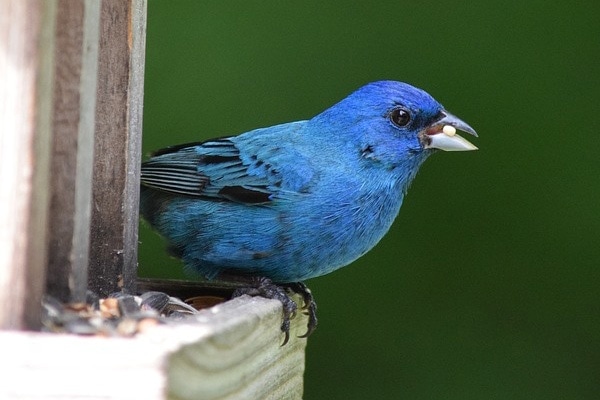
Also, at 22% frequency, next on the list is the Indigo Bunting, a bright blue bird with black wingtips and a silver-gray bill.
These birds are mainly found in the eastern parts of the US, where Maine is the edge of their territory. The birds breed only in the northern parts of Maine, and because they’re long-distance migrants, they winter down to Mexico and even reach South America.
Only male Indigo Buntings show a remarkable bright blue color. Females, on the other hand, are brown-colored birds with faint streaks on their breasts.
Indigo Buntings mainly breed in areas where there are lots of bushes or weeds. These could be roadsides, old fields, wood edges, and along streams, rivers, roads, or powerlines.
These birds mainly forage in open areas like fields, grasslands, lawns, and other open spaces with shrubs and trees. They also eat a variety of food which includes insects, seeds, and berries.
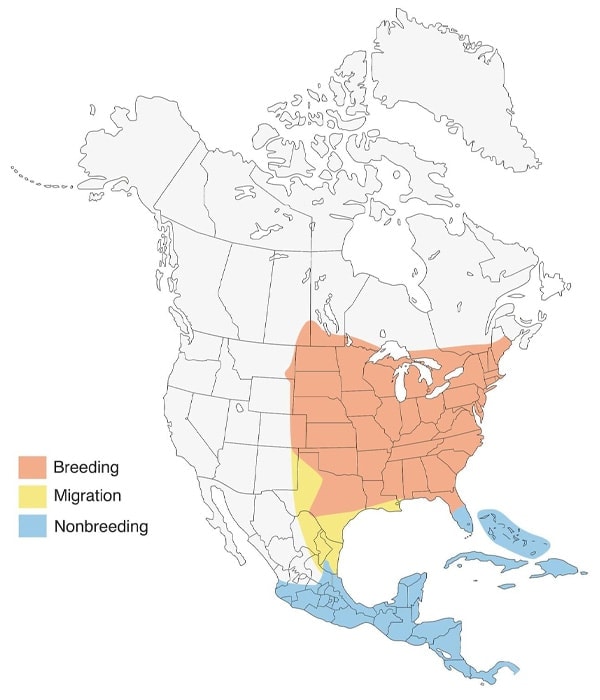
15. Bald Eagle (22% Frequency)

Another common bird you’d find in your backyard in Maine is the Bald Eagle, with 22% frequency.
These large-sized birds grow at a length of 27.9 to 37.8 inches and weigh around 105.8 to 222.2 ounces. They have white, feathery heads, dark brown bodies and wings, whitetails, and yellow bills.
I’m sure everyone recognizes the Bald Eagle. After all, it has been the national emblem of the US since 178, and for many native people, it has been a spiritual symbol for decades.
They suffered a decline in numbers a long time ago, but thanks to efforts to protect their numbers, they now belong to the list of birds of low concern.
In Maine, there are over 750 nesting pairs of Bald Eagle. They mainly breed in forested areas near bodies of water and far from developed areas that might harm their natural habitats.
In some areas of Maine, Bald Eagles are resident birds. However, there are a few numbers that only stay in Maine for winter and breed in Alaska or Canada.
During the winter season, the birds come out of their forested homes and can be seen in dry and open uplands where there’s open water so they can eat. Their diet is composed mainly of fish, but they also eat reptiles, mammals, amphibians, invertebrates, and even birds.
There’s no denying that Bald Eagles are powerful birds. They are one of the birds that are on top of the food chain as predators. But, these birds are also sometimes harassed by fellow raptors or even small birds like blackbirds and crows.
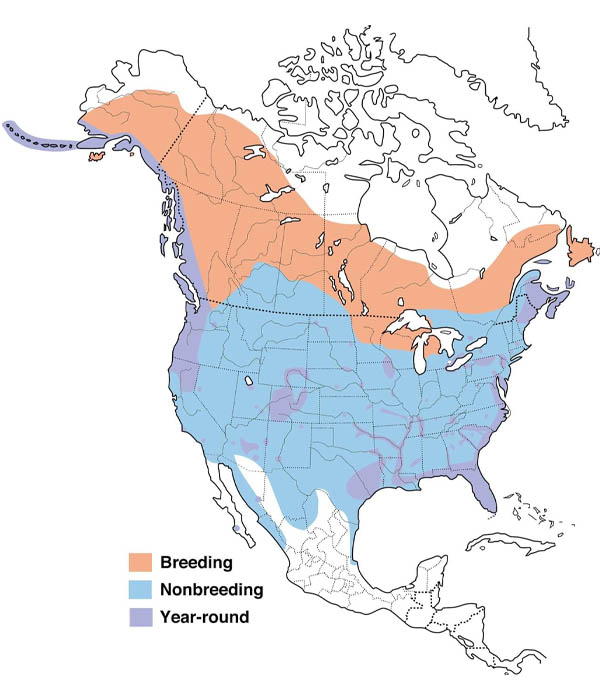
16. American Robin (20% Frequency)
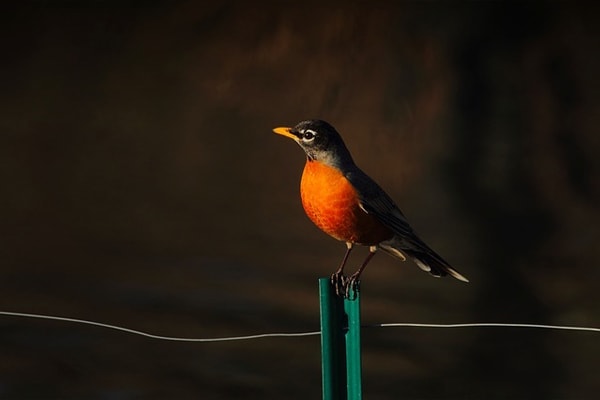
The American Robin is another widely distributed bird that is found all year round in Maine. They have a record of 20% frequency in the backyard.
These are medium-sized birds that grow at a length of 7.9 to 11 inches and weigh around 2.7 to 3 ounces. They are easily identified with their gray-brown bodies, black-colored heads, and orange chests. Male and female birds look different from each other, with females appearing paler than males.
American Robins adapt well to any type of environment. They are generally common in parks, gardens, farms, lawns, and forest edges. They are social birds that are very friendly with people. However, no matter how friendly they are, they are not frequent visitors of bird feeders.
These birds don’t eat seeds.
They prefer eating insects and fruits, instead. So, if you plan to attract them, making your backyard insect-friendly and growing some fruit-bearing plants and trees would be your best options.
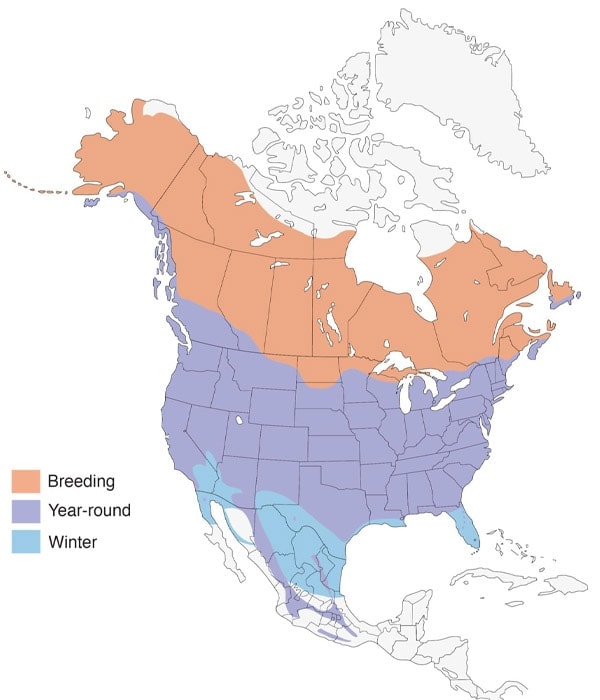
American Robins are also known for their familiar and beautiful tunes. Most people describe it as the sound of spring, mainly because these birds usually arrive at the start of spring.
You can listen to the American Robin’s beautiful song in the video below:
17. Black-capped Chickadee (19% Frequency)
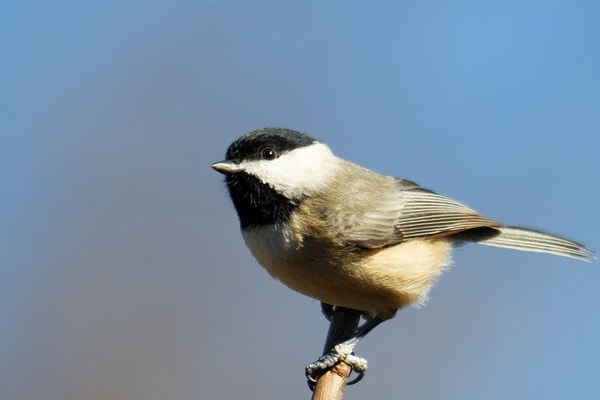
At 19% frequency, the next bird on our list is the Black-capped Chickadee, one of the most loved birds in Maine. In fact, the people of Maine love this bird so much that they named it Maine’s official state bird in 1927.
With these birds’ cute appearance, no one can question why many people love them so much. They are very small and only grow at a length of 4.7 to 5.9 inches and weigh about 0.3 to 0.5 ounces.
However, the birds’ small size is not only what makes them cute. They also feature round-shaped bodies, a large head, and short necks, making them very adorable to look at.
The birds’ are easily identifiable with their black and white color combination. As their name implies, the birds feature a black cap, two white stripes on their cheek, and a small black bib right under their bill. Their bodies are colored white, while their back and tail areas are a grayish-black color.
These adorable little birds are frequent backyard feeders throughout the state of Maine all year round. They are also very common in open woods, mixed forests, cottonwood groves, thickets, and parks.
These birds are described as very active, acrobatic, and curious birds. It’s actually thanks to their curiosity that makes them very easy to attract.
It’s observed that Black-capped Chickadees are usually the first birds to visit the backyard once a bird feeder is set up. So, make sure to have some sunflower seeds, peanuts, mealworms, and suet prepared for these birds.
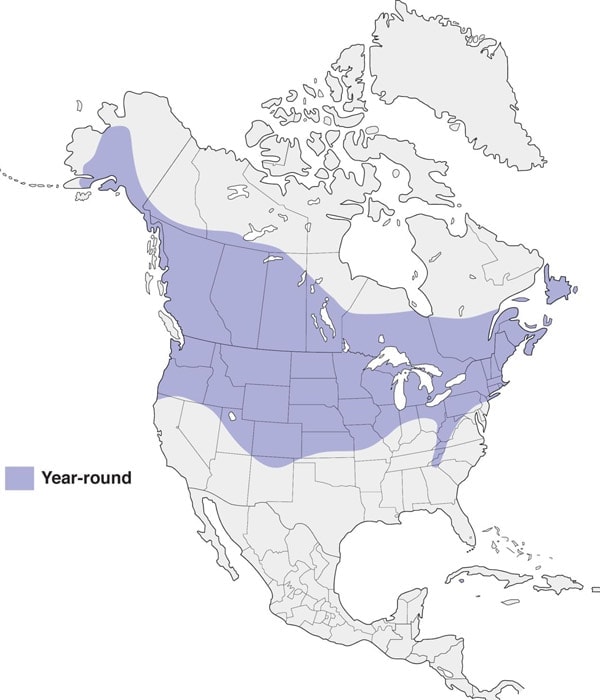
18. Blue Jay (19% Frequency)
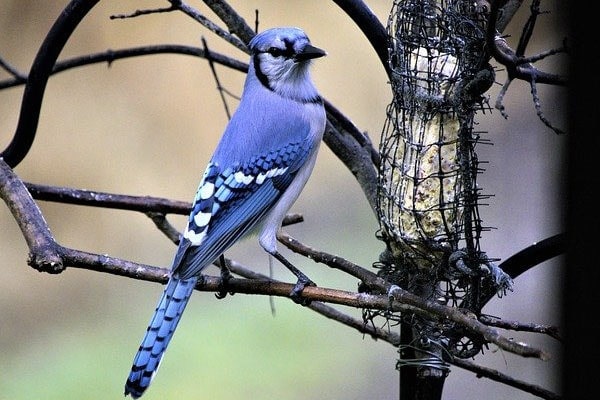
The Blue Jay is a beautiful bluebird found primarily in the eastern part of the US, including Maine. They show up in bird feeders at 19% frequency. 0
These birds are very easy to identify, thanks to their beautiful blue color. They are medium-sized birds around 9.8 to 11.8 inches long and weigh approximately 2.5 to 3.5 ounces. They have blue, black, and white-colored backs, while their chests are white or light grey.
However, despite the birds’ beautiful appearance, still, many people dislike them. And this is mainly because Blue Jays have been considered as bully birds.
If given the opportunity, Blue Jays will drive away small birds from bird feeders and take a lot of food for themselves. And though this may seem selfish, perhaps it’s time to understand these birds.
Although it may appear that Blue Jays are eating more of the food, the truth is that they are actually storing food in their throat sacks. They’ll fit as much food as they can and leave quickly to find shelter.
If you’re worried about the small birds, you can hang some peanut feeders. As Blue Jays are one of those birds who can most likely crack open peanut shells, they’ll prefer those over smaller seeds.
These birds are found in different kinds of forests in Maine, but most prefer to stay in forest edges. They also usually stay near bird feeders, especially in winter, when food tends to be scarce.
Blue Jays stay all year round in Maine, so expect them to visit your bird feeders often, take food, and leave.
If you’re curious if you have Blue Jays visiting, you’ll most likely notice them immediately as they’re one of the noisier birds. They can even imitate the sound of a hawk to warn other birds when a predator is present or if they just want birds to fly away to give them more space.
Overall, these are really smart birds.
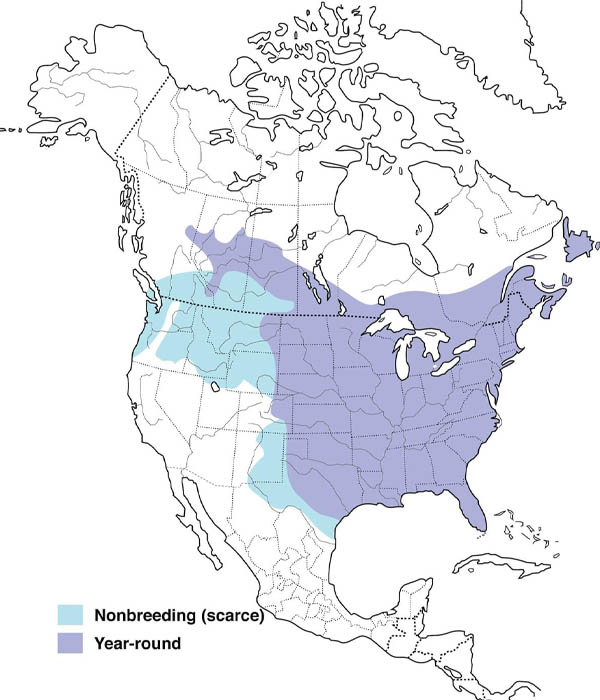
19. White-breasted Nuthatch (19% Frequency)
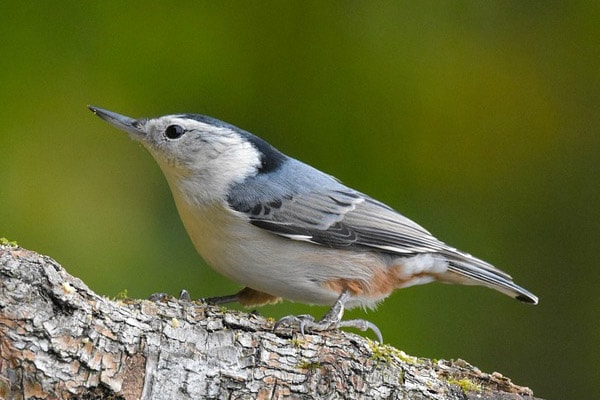
Also, at 19% frequency, the White-breasted Nuthatch is another beautiful bird seen everywhere in Maine.
Although known as the largest nuthatch, these are still small-sized birds that only grow at a length of 5.1 to 5.5 inches and weigh only about 0.6 to 1.1 ounces. They are known for their clean gray-blue back, white chest (as their name implies), white face, and dark head.
These birds are non-migratory, which means you can expect to see them all year round in Maine.
They are most often found in deciduous forests but are also present in woodland edges and other open areas with large trees. These birds can also easily socialize with humans, which makes them very common visitors of bird feeders.
White-breasted Nuthatches love nuts and seeds. As their name implies, these birds are really good at opening nuts by jamming them in barks and hammering them.
If you wish to have these birds visit you, too, filling your bird feeders with sunflower seeds, safflower seeds, peanuts, and mealworms would be a good idea. During winter, you can hang some suet feeders, too.
One interesting behavior of these birds is that they tend to store food in winter. They would usually keep seeds or insects they find under loose barks within their territory to eat them later.
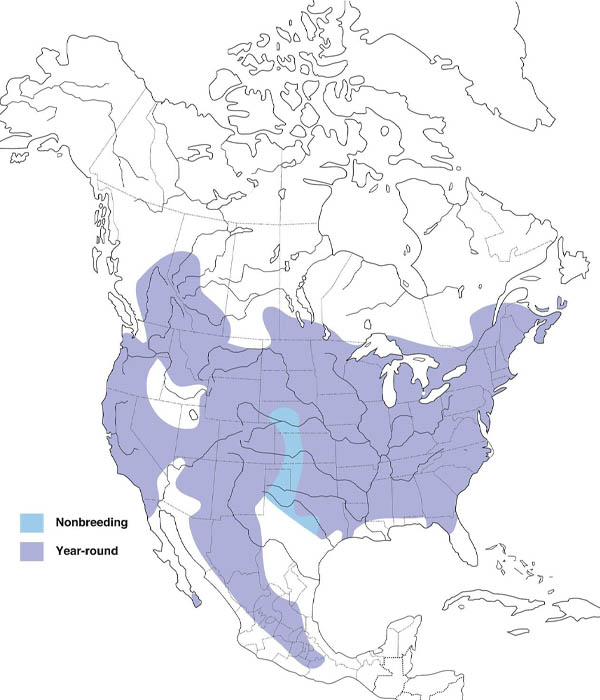
20. American Crow (18% Frequency)
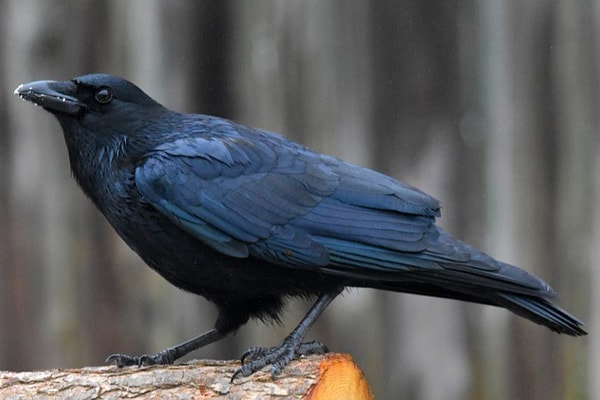
The American Crow is a large bird that is easily identifiable with its overall black color. It shows up in backyards at 18% frequency.
These birds grow at a length of 15.8 to 20.9 inches and weigh around 11.2 to 21.9 ounces. It also features a long pair of legs, a thick neck, a heavy bill, and broad wings with a length of 33.5 to 39.4 inches.
These birds are the most frequently seen among all bird species found in Maine. They are seen all year round, mainly in the southern parts of the state.
American Crows are adaptable birds and can be seen in various habitats, including farms, fields, woods, parks, roadsides, and near bodies of water like rivers and streams.
They are not very frequent visitors of backyard feeders. This is because not everyone loves having crows around.
These birds can be quite bullies and can easily scare other birds away. But if you’re interested in attracting a group of crows in your yard, you can simply hang some peanut feeders.
You can often see these birds in large groups, whether it’s the breeding or winter season. They are very sociable birds, and this close family bond helps them survive.
During the breeding season, a pair of American Crows are often assisted by their offspring during the last breeding season. And the whole family cooperates in raising the new hatchlings.
In the winter months, American Crows are often seen gathered in large roosts to protect themselves from harm. Usually, only one crow will check the area when searching for food while another watches his back. Once confirmed that the site is safe, other crows will follow to feed.
Because of this behavior, the birds became known as one of the smartest bird species in Maine.
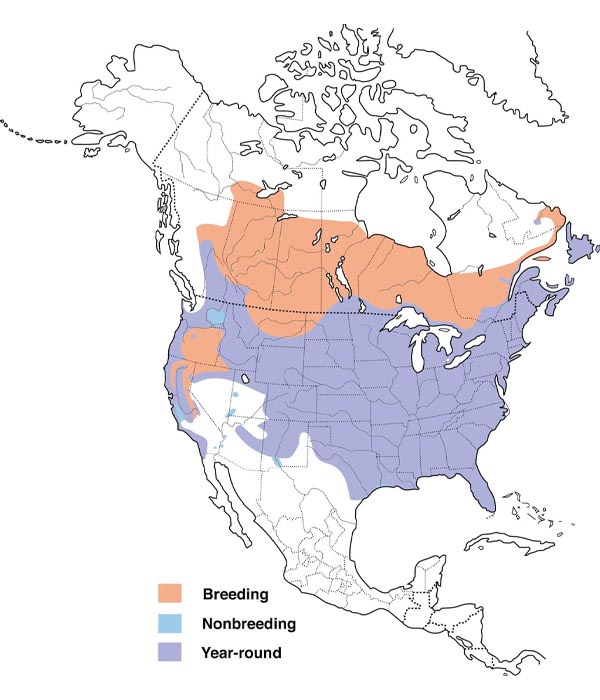
21. Downy Woodpecker (18% Frequency)
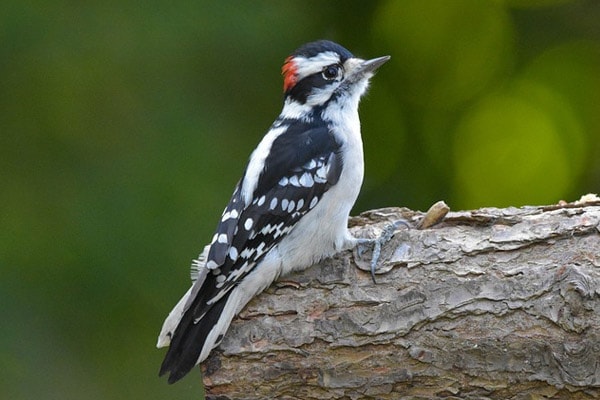
Another woodpecker on this list is the Downy Woodpecker, who shows up in backyards at 18% frequency. Downies are the smallest woodpecker you’d find in Maine.
These birds grow at a length of 5.5 to 6.7 inches and weigh around 0.7 to 1 ounces. You’ll easily identify these birds because of their black and white checkered pattern. You’ll also notice some white spots on their wings and black spots on their outer tail feathers.
Male and female birds look very similar to each other except for a red spot on the male birds’ necks.
The Downies are commonly found in Canada and upper parts of the US, which includes Maine. These birds don’t migrate, so expect to see them all year round.
These birds love staying in open deciduous woods and areas near streams. They can also be found in places where humans are near, like parks, suburbs, and orchards. That also means you can easily attract them to your bird feeders.
All you need to use are some of their favorite foods like suet (for winter), sunflower seeds, and peanuts.
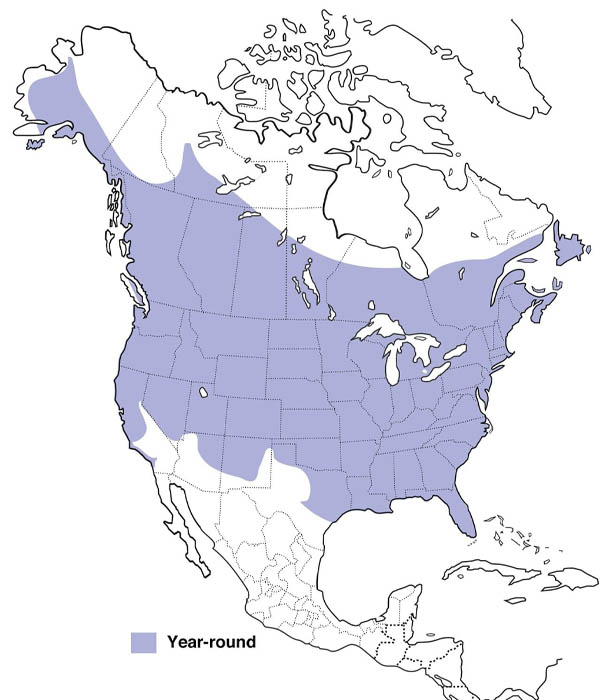
22. Evening Grosbeak (18% Frequency)
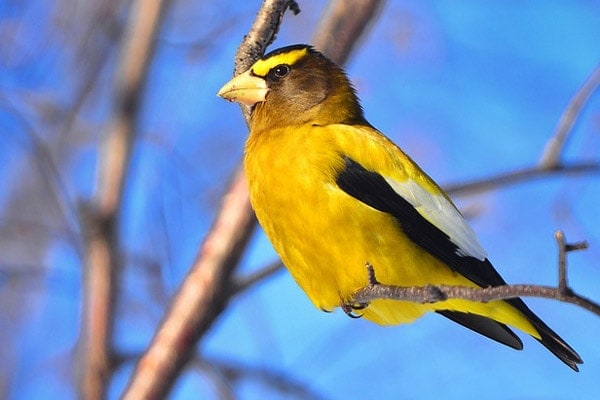
Next on our list is the Evening Grosbeak, with an 18% frequency of occurrence in the backyard. They are medium-sized birds that grow at a length of 6.3 to 7.1 inches and weigh around 1.9 to 2.6 ounces.
Male Evening Grosbeaks are easily identified with their yellow and black-colored feathers. You’ll notice a distinct white patch on their wings and a bright yellow stripe on top of their eyes. On the other hand, females are pale white with a slight hint of yellow by the neck area. Their bills are a bit greenish, compared to the males that are pale yellow.
Evening Grosbeaks are irregular migrants in the US, but they are resident birds in most parts of Maine.
These birds breed primarily in coniferous forests. They might also build nests in deciduous woods, parks, and orchards, but this is not common. However, during winter, they can live in coniferous forests, deciduous forests, urban and suburban areas.
The birds eat various food, including insects, seeds, and fruits, with insects composing the most of their diet.
These are very social birds that often forage in flocks. There’s very little to no aggression between their species in a year, which is not commonly seen in many birds.
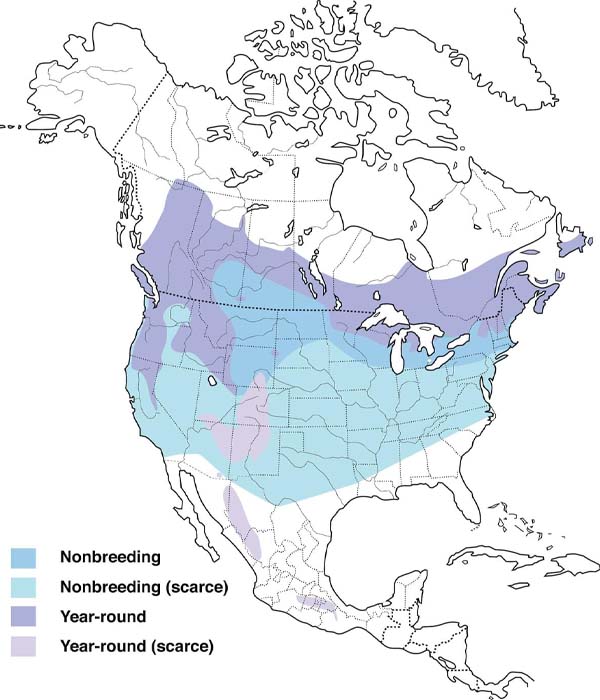
23. Common Raven (18% Frequency)
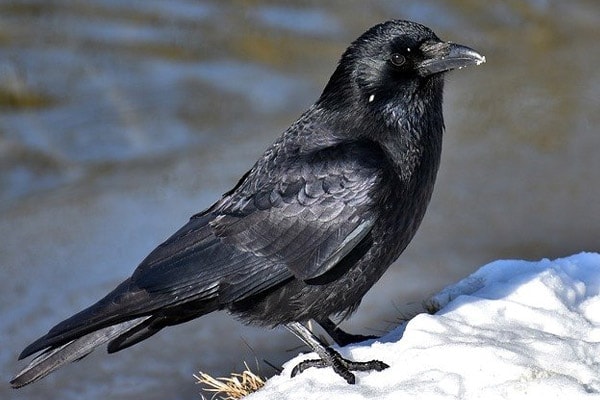
Another bird most commonly seen in backyards in Maine is the Common Raven, with an 18% frequency of occurrence.
These birds look very similar to crows but only in terms of color.
They feature a much larger and heavier beak, a wedge-shaped tail, and a croaking sound. They are also a lot larger and grow at a length of 22.1 to 27.2 inches and weigh around 24.3 to 57.3 ounces.
Common Ravens are widespread in North America. They are resident birds that breed in Alaska, Canada, southern parts of the US, Mexico, and some eastern states, including Maine.
The birds can occupy various habitats, including forests (coniferous and deciduous), deserts, mountains, beaches, islands, open fields, areas near water sources, and even in areas near people like the rural areas, farms, parks, and backyards.
These birds adapt really well when there are changes. They survived habitat loss by staying close to humans and sometimes eating human scraps thrown in the garbage or on the ground. But like some birds, Common Ravens can eat almost anything, including insects, grains, berries, seeds, and even small animals like mice and fellow birds.
Common Ravens are always fascinating to watch. Their actions are very intelligent, making them one of the favorites to watch by many Maine residents.
It’s also observed that they’re a lot more graceful than crows, especially when in flight.
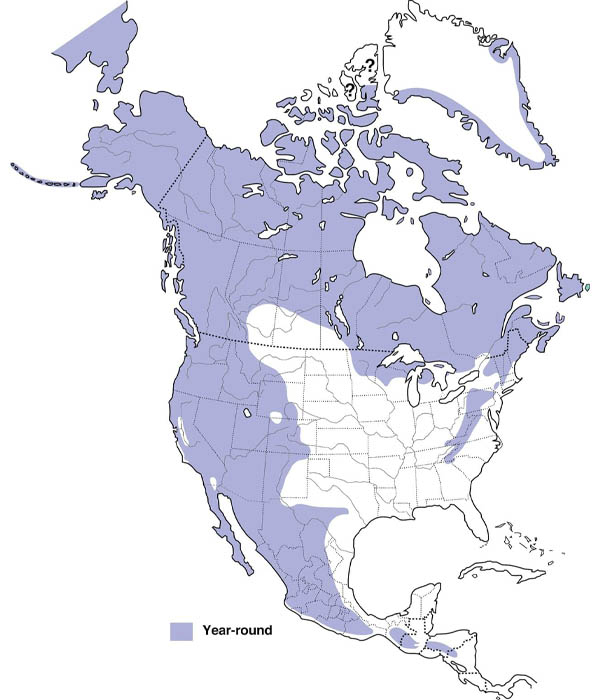
24. Common Grackle (18% Frequency)
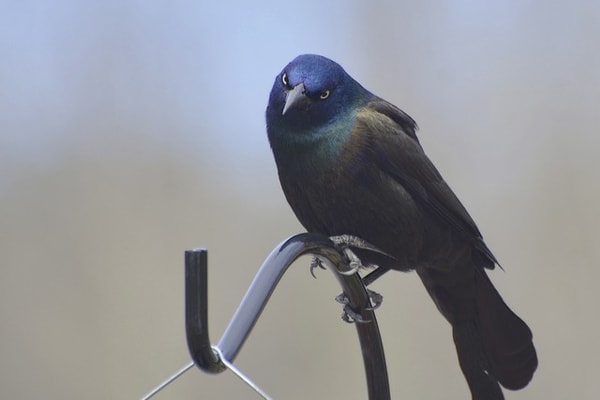
The Common Grackle is a native bird in Maine and is commonly found throughout the state during the breeding season. They occur pretty frequently in the area, and I recorded it at 18%.
They usually travel short-distance down south for winter, leaving Maine around autumn. But as soon as the breeding season starts, they’re also the first birds to arrive in spring.
These birds are medium in size, growing at a length of 11.0 to 13.4 inches and weigh around 2.6 to 5.0 ounces. From afar, Common Grackles may look black. But you’ll most likely recognize the beauty of these birds with their glossy purple heads and iridescent bronze bodies.
Male and female birds look distinct from each other, with females appearing less glossy than males.
Common grackles are often described as very resourceful birds. They adapt well in any type of environment, whether in natural habitats or human landscapes. They’re very common in open woods, forest edges, wetlands, fields, parks, suburbs, and grasslands.
These birds are very common in bird feeders. They eat almost anything, even garbage! And they usually forage in large flocks.
Because of this, they tend to scare smaller songbirds which can be frustrating for most bird watchers.
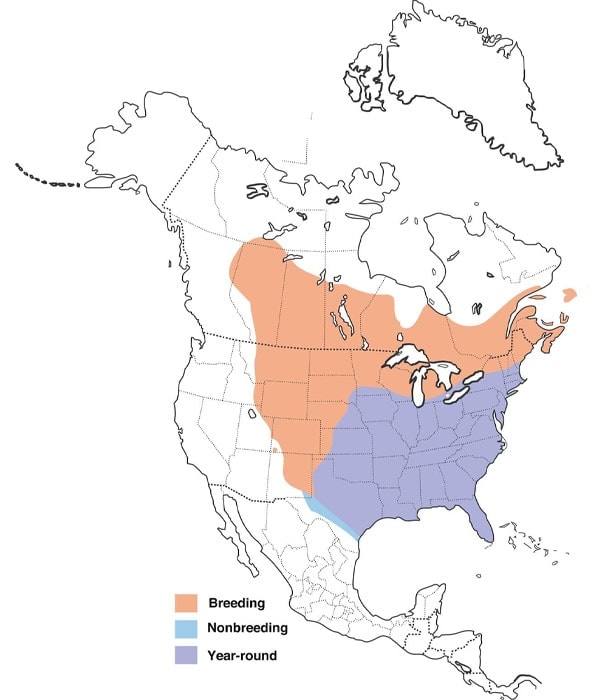
25. European Starling (17% Frequency)
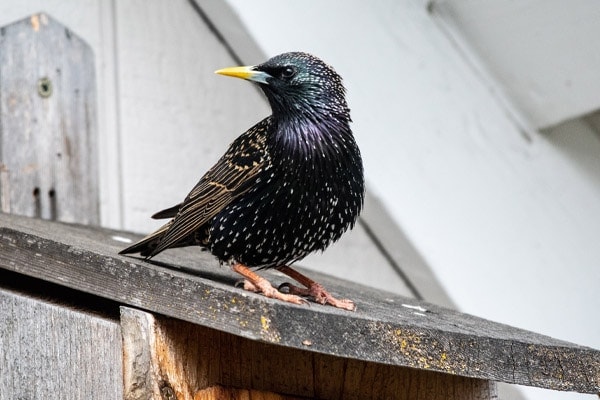
The European Starling is another invasive species on this list.
These birds were only introduced in the year 1890, and thanks to their really good ability to adapt to any environment, they managed to survive. Now, they are widespread birds seen everywhere in Maine all year round.
European Starlings are beautiful birds that have a 17% frequency of occurrence in backyards. They are almost the same size as the blackbirds and grow at a length of 7.9 to 9.1 inches and weigh around 2.1 to 3.4 ounces.
When viewed at a distance, these birds may look black overall. However, their beauty really comes out in summer with their purplish-green iridescence. Once winter comes, European Starlings lose this factor and are seen to be brown with many white spots.
These birds can be found everywhere, but they mostly stay in areas where there are many people. So this can be in the streets in cities, lawns, fields, building or tree cavities, and other open, grassy areas with a nearby water source.
They are also frequent visitors of bird feeders, which can be fascinating to look at at first. However, once they come in large numbers, they tend to outcompete native species, occupying bird feeders for themselves.
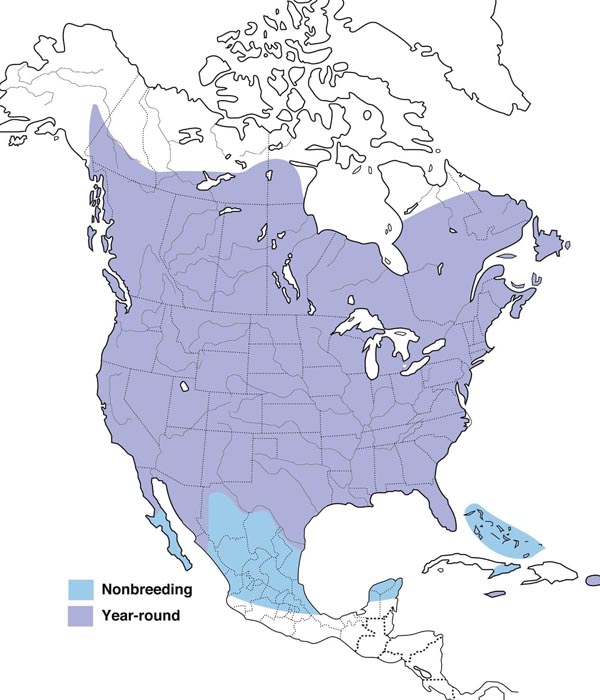
26. Yellow-rumped Warbler (17% Frequency)
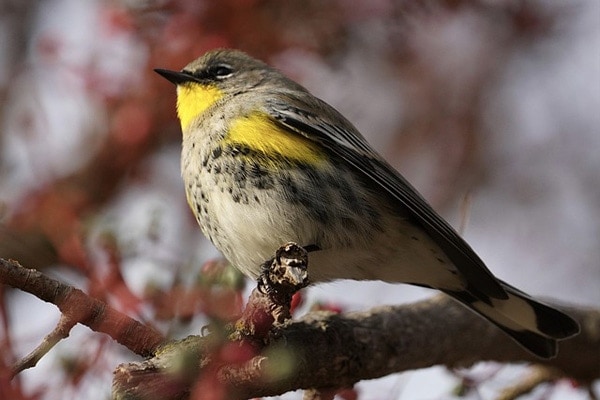
The Yellow-rumped Warbler, at 17% frequency of occurrence, is another beautiful bird that is usually found in Maine during the breeding season. They are small-sized birds that grow at a length of 4.7 to 5.5 inches and weigh around 0.4 to 0.5 ounces.
The birds have gray-colored bodies with a bit of white mixed in their tails and wings and bright yellow color on their face, sides, and, as their name implies, rump. Male and female Yellow-rumped Warblers look very similar, with females looking duller than the males and have a few brown parts.
These birds are widespread in North America. They breed in Alaska, Canada, some parts of the southern and eastern US, including Maine. They mainly breed in coniferous and mixed woodlands and sometimes in mountain areas.
During winter, the birds move to more open areas with lots of access for shrubs and trees for food. At these times, you’ll find most of them in parks, along streams, open forests, fields, and, of course, your backyards.
These birds eat a variety of food, from insects to bird seeds. So, if you’re planning to welcome them in your backyard, you can serve some sunflower seeds, peanut butter, and suet. You can also plant a variety of berries that these birds can enjoy.
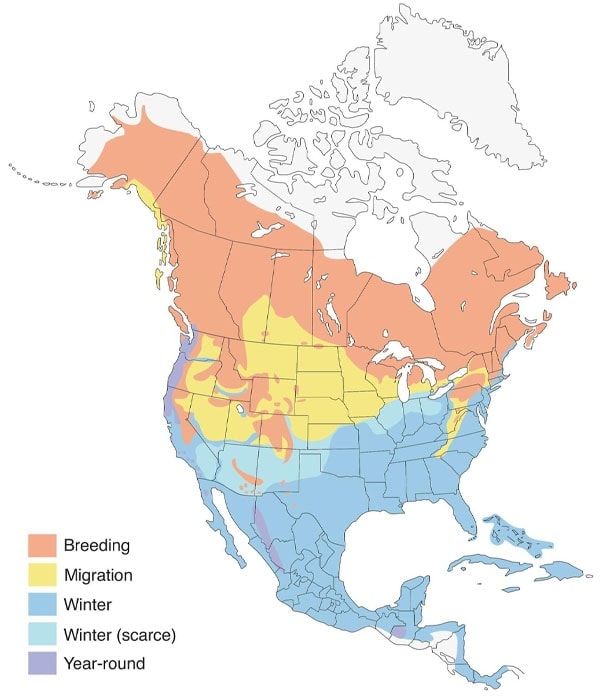
27. Song Sparrow (16% Frequency)
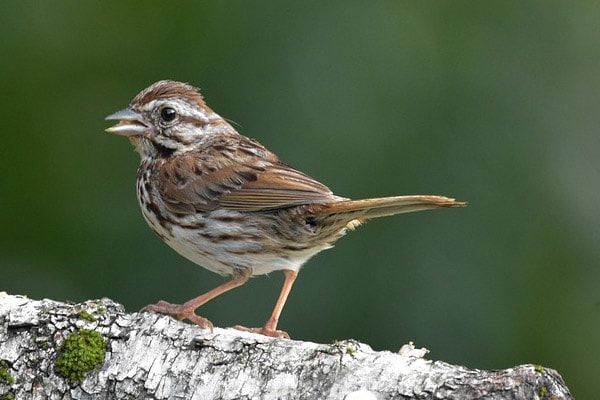
The Song Sparrow is one of the easiest sparrows to identify, and they occur in backyards at 16% frequency.
These are small-sized birds that grow at a length of 4.7 to 6.7 inches and weigh around 0.4 to 1.9 ounces. They feature brown-colored feathers with prominent white thick streaks on their chests. You’ll also notice that they have a brown crown with a grey stripe in the middle of their head, eyebrows, and cheeks.
These birds are most often seen in various open habitats like parks, grasslands, marshes, overgrown pastures, agricultural fields, forest edges, suburbs, and mixed woodlands. In Maine, you’ll most often see them anywhere that’s wet, shrubby, and open.
Song Sparrow birds mainly stay in Maine during the breeding season, which is from April to August. But as medium-distance migrants, the birds fly down south for winter.
These birds eat more insects in summer in preparation for the breeding season. Food choices would include beetles, caterpillars, spiders, snails, dragonflies, grasshoppers, and earthworms. They then supplement these foods with plant material.
So, if you’re planning to welcome Song Sparrows for their breeding season, it’s highly recommended to make your yard insect-friendly. You can also provide some nesting materials so that the birds can build their nests too.
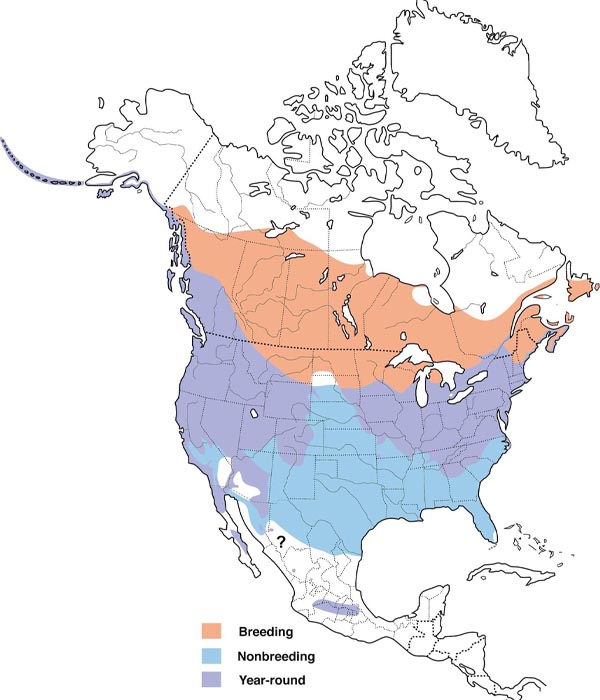
One loving feature these birds have is their beautiful tune. If you have a Song Sparrow living near you, then they’re most likely the first voices you’ll hear in the morning.
Just listen to their beautiful song in the video below:
28. Dark-eyed Junco (16% Frequency)
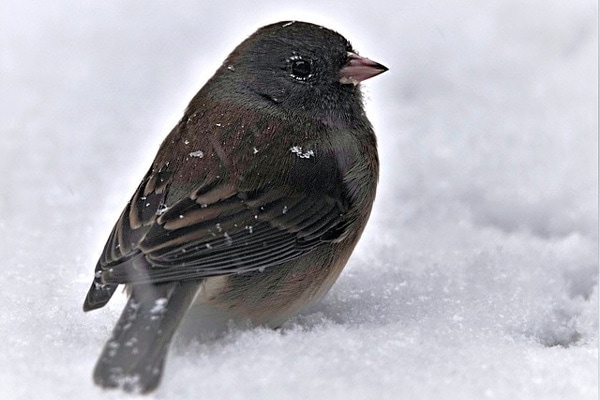
The Dark-eyed Junco is a small-sized bird found in Maine all year round. They also occur in backyards at 16% frequency.
They grow at a length of 5.5 to 6.3 inches and weigh around 0.6 to 1.1 ounces. The appearance of these birds may differ depending on where they are, but in Maine, they are seen to have pale-gray bodies with white bellies.
Male and female birds are very distinct, with female Dark-eyed Juncos having tan or brownish-colored bodies with white bellies. They are also quite smaller than the males.
Dark-eyed Juncos commonly breed in coniferous forests with elevations that range from sea level to 11,000 feet or more. But in winter, the birds are more spread out and are seen in many open woodlands, roadsides, parks, and fields.
These birds love seeds as it makes up around 75 percent of their diet. This is why these birds are one of the frequent visitors of backyard bird feeders.
They usually gather under bird feeders to eat seeds that have fallen. In winter, you’ll usually find them in large flocks along with other sparrows and bluebirds.
If you wish to attract them, laying out some ground feeders filled with their favorite seeds would be a great idea.
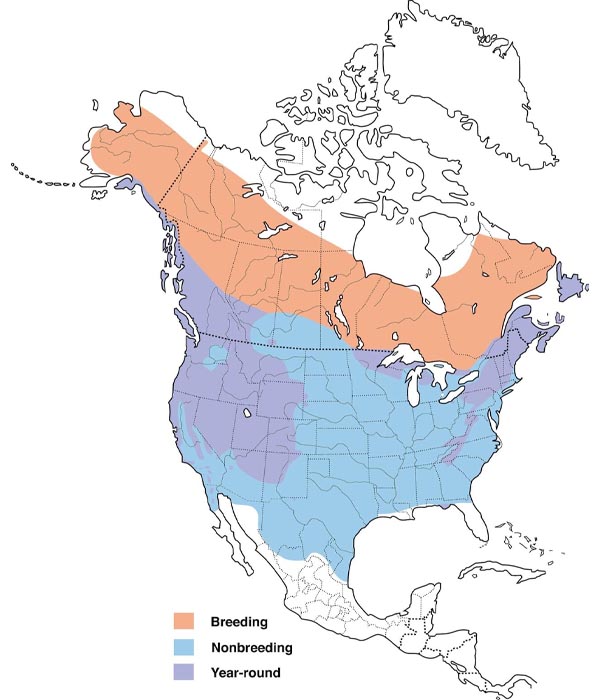
29. Tufted Titmouse (15% Frequency)
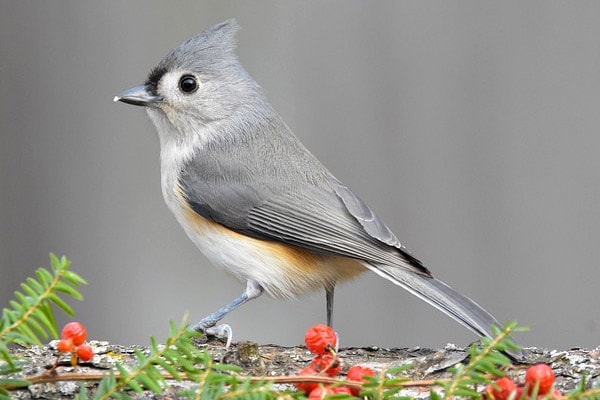
The Tufted Titmouse is a non-migratory bird found in the eastern part of the US. The state of Maine is considered the edge of their territory, but they’re only found in the northern half of the state.
These small-sized birds occur in backyards at 15% frequency.
They are known to grow at a length of 5.5 to 6.3 inches and weigh around 0.6 to 0.9 ounces. These birds feature a silvery-gray-colored back, wings, and tails, and a white-colored chest. Their cheeks are white, and you can see an obvious black patch just above their bills.
Tufted Titmice are known to be acrobatic birds and are commonly seen in deciduous or mixed woodlands. They can also be seen in areas near people like orchards, parks, and backyards.
However, despite being common visitors of backyard feeders, Tufted Titmice are actually shy birds. They would just usually fly in bird feeders, grab a seed, and fly somewhere else to eat the seed in private.
You can attract these birds using sunflower seeds, safflower seeds, and peanuts. If it’s winter, the birds would also happily fly in if you have suet feeders.
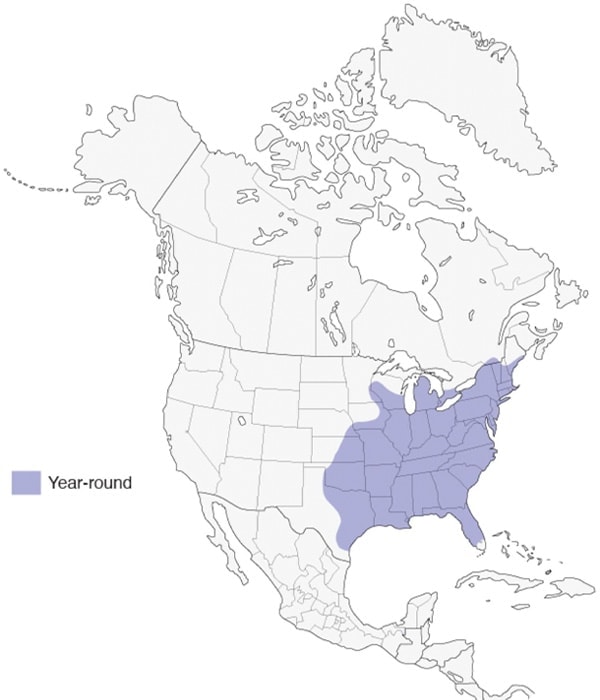
30. Brown-headed Cowbird (15% Frequency)
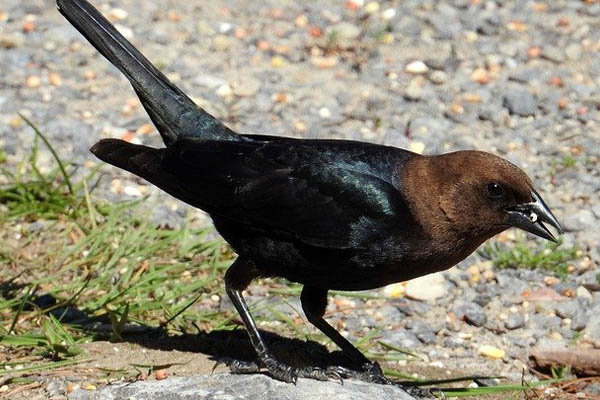
Also at 15% frequency of occurrence is the Brown-headed Cowbird, a small bird that grow at a length of 6.3to 8.7 inches, depending on the bird gender.
These birds belong to the family of blackbirds. Male birds wear glossy black-colored feathers all over their body except for their head. As the name implies, Brown-headed Cowbirds have brown heads that appear black at a distance.
Females, on the other hand, wear brown-colored plumage all over their bodies. But their beaks are black.
Most Brown-headed Cowbirds, particularly in the northern parts of Maine, only stay during the breeding season. They are short-distance migrant birds, so they move down to Mexico or Florida for winter. However, there are several Brown-headed Cowbirds in the southern parts of Maine that stay all year round.
These birds are mainly found in grasslands, edges of forests, fields, pastures, orchards, and even backyards. They don’t really like spending time in forests with large trees around. As for food, they eat a variety of them, which includes seeds, grains, grasses, and insects.
Brown-headed Cowbirds are quite social birds that are often seen in large flocks along with other blackbirds.
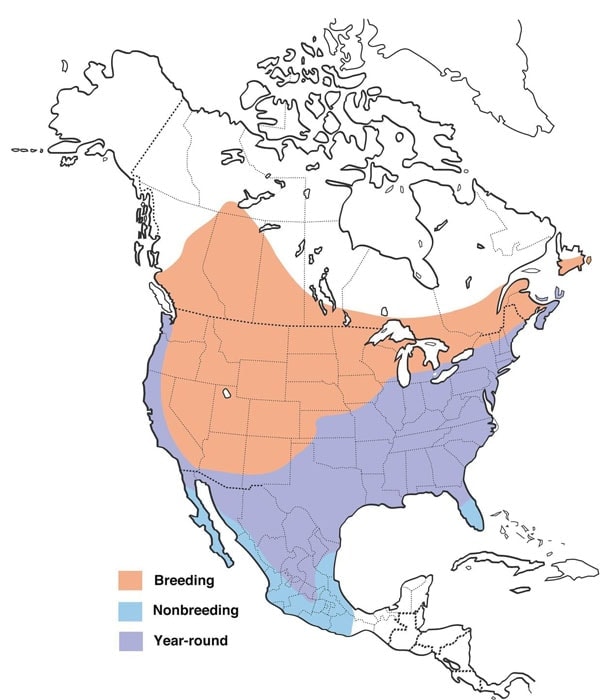
31. Chipping Sparrow (14% Frequency)
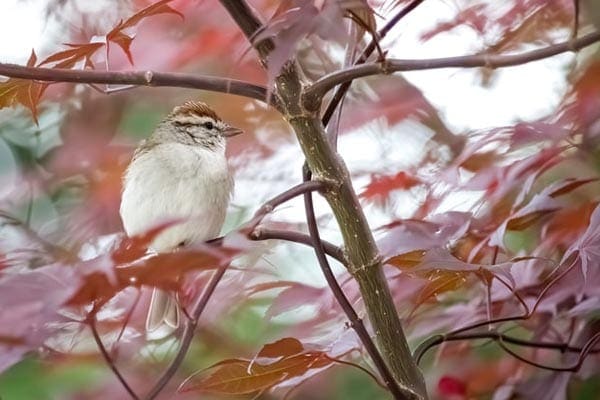
The Chipping Sparrow is another sparrow that breeds in Maine. They are found in backyards at 14% frequency.
They are small-sized birds that grow at a length of 4.7 to 5.9 inches and weigh around 0.4 to 0.6 ounces. They feature a pale face, rusty crown, brown and black back and wings, and pale gray underparts. You’ll also notice that they have a black line on their eyes.
Male and female birds look very identical, with males being only a bit larger than the females. Male birds are also believed to have a larger wingspan and bigger bellies.
Chipping Sparrows are seen anywhere with trees. This includes woodlands and forest edges, backyards with many trees, parks, and grassy forests. Even if these areas are near people, these birds don’t seem to mind.
These birds are very territorial during the breeding season. So, if you plan to attract them through bird feeders, it’s best always to create a distance between each feeder. You can also plant some shrubs or small trees around so these birds can nest.
The birds leave Maine after the breeding season, so you might not see them during the winter months. As short-distance migrants, these birds fly down south to Mexico, California, and Florida after breeding. So just wait for the next spring, and they’ll surely come back.
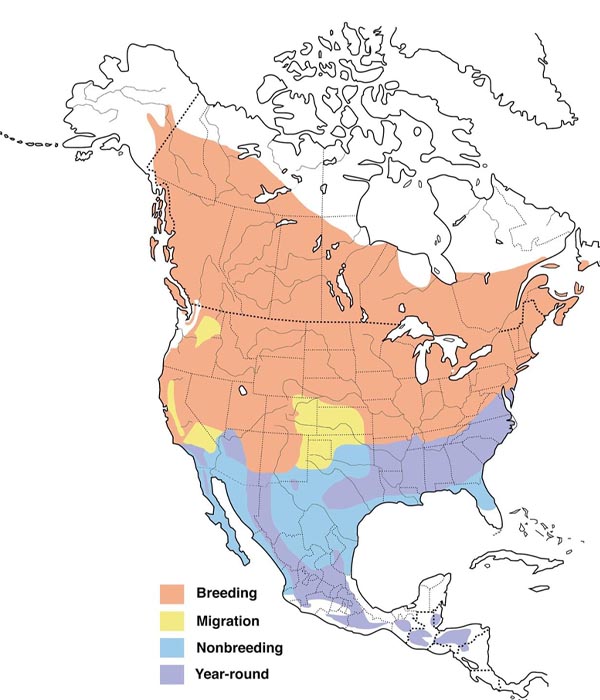
32. Eastern Phoebe (14% Frequency)
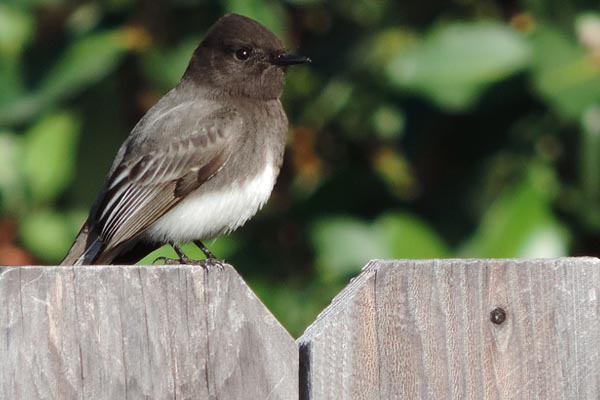
Next on our list, at 14% frequency of occurrence, is our famous flycatcher from the east, the Eastern Phoebe.
These small birds grow at a length of 5.5 to 6.7 inches and weigh around 0.6 to 0.7 ounces. The birds feature brownish-gray-colored upper parts with white underparts. Their large heads are of a much darker color than their bodies, and they have darker bills.
Eastern Phoebes are mainly found in the eastern parts of the US and Canada. They are only seen in Maine during their breeding season, while they migrate down south for winter.
These birds nest in wooded areas that are near water sources. They are also found near human structures that offer many nest materials, vegetation, and perches. This can be in buildings, decks, and even bridges.
Because they’re known as flycatchers, flying insects make up most of the Eastern Phoebe’s diet. This includes flies, moths, wasps, dragonflies, beetles, and butterflies.
The birds would often sit on a low perch and look out for insects nearby. Once they detect one, they immediately fly off the perch to catch it, and once they’re done, they go back immediately to their perch, waiting for more.
Wondering why these birds are called Eastern Phoebe? Try to listen to tier famous bird call:
Most people immediately recognize the eastern phoebe because of their bird call. It’s almost like they want you to know that they’re just around.
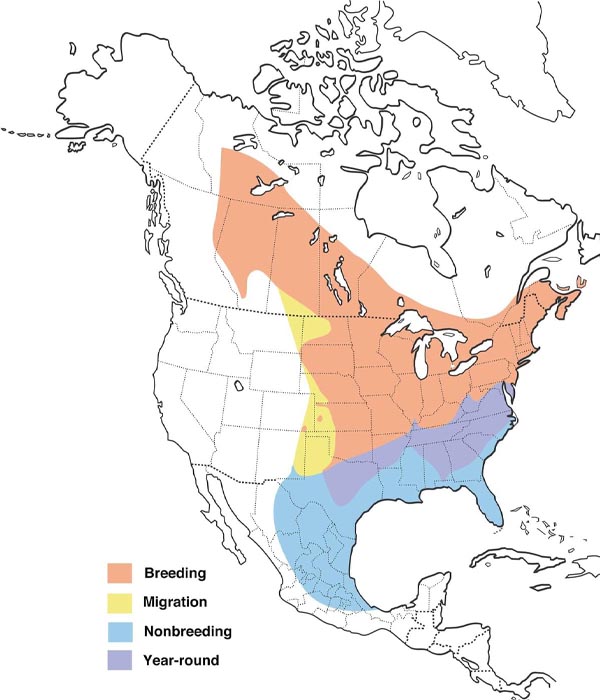
33. Hawk (14% Frequency)
At 14% frequency, we have the hawks. These big birds are also fascinating to see, and it seems that they are growing in numbers around Maine.
There are currently eight species of hawks found in Maine.
- Broad-winged Hawk
The Broad-winged Hawk is the most common species of hawk seen commonly in Maine. They grow at a length of 13.4 to 17.3 inches and weigh around 9.3 to 19.8 ounces. Despite their small size, these birds are known for their broad wings.
You can quickly identify these hawks from their reddish-brown color with white bars on their chest. In-flight, you’ll notice that they have white underwings with brown to black edges.
There are two variations – the light morph, which is the most common, and the dark morph, which is quite rare.
- Cooper’s Hawk
The Cooper’s Hawk is known for its skillful flying abilities. Male birds grow at a length of 14.6 to 15.3 inches, while females grow larger at 16.5 to 17.7 inches.
These birds feature bluish-gray upperparts and white-colored underparts with reddish-brown bars. On top of that, you can easily notice the black and white appearance of their underwings and tail when they’re in flight.
- Rough-legged Hawk
The Rough-legged Hawk is a lot larger than the Cooper’s and Broad-winged Hawks. They grow at a length of 18.5 to 20.5 inches and weigh around 25.2 to 49.4 ounces.
These birds are dark brown with beautiful, bold patterns. In-flight, you’ll notice that they have white underwings, with blacks lower edges and an alternate black and white pattern on the upper edges.
The birds also appear in light and dark morphs. Both variations almost have similar-looking patterns, but the dark morph appears closer to a black and white combination than a brown and white combination.
- Red-tailed Hawk
The Red-tailed Hawk is known as the second-largest Buteo Hawk in North America. Male birds grow at a length of 17.7 to 22.1 inches, while females grow at 19.7 to 25.6 inches.
As their name implies, these birds have cinnamon-red tails with pale red undertails. Their upperparts are colored brown, and their underparts are white with black edges and a few bars in the middle.
Like many hawks, Red-tails also have two variations, the light morph, and the dark morph. The dark morph appears black throughout, except for the half part of their underwings which is colored white.
- Red-shouldered Hawk
The Red-shouldered Hawk is commonly seen in forests and grows at a length of 16.9 to 24.0 inches. These birds are quite colorful and are greatly known for their red shoulders.
These birds have a dominant warm reddish color, black and white checkered upperparts, and barred underwings. Their tails fan out as they fly and are observed to be barred, too.
- Sharp-shinned Hawk
The Sharp-shinned Hawk is a lot smaller than the other hawks on this list. They grow at a length of 9.1 to 13.4 inches and weigh around 3.1 to 7.7 ounces. They are beautiful birds with bluish-gray upperparts and red-orange barred breasts.
- Northern Goshawk
The Northern Goshawk is a large hawk that grows at a length of 20.9 to 25.2 inches. They feature a dark gray color all over their bodies, with their upperparts appearing darker than their underparts. You’ll also see a noticeable white line over the eye.
Hawks are widespread all over Maine. Whether it’s summer or winter, you’ll find a hawk around. When you think hawk species left, you’ll observe that another hawk species would show up. That’s how things are.
34. Gray Catbird (13% Frequency)
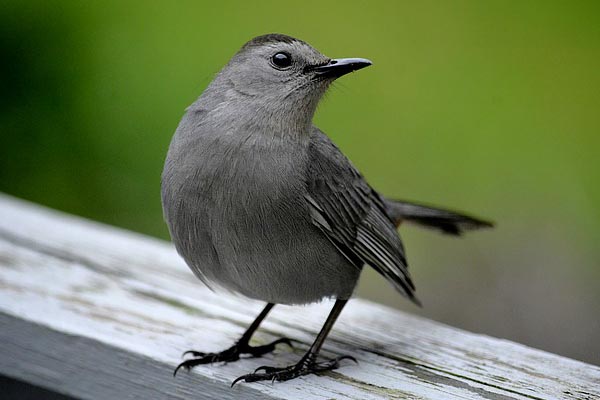
The Gray Catbird is a beautiful and unique-looking bird you’ll find breeding in Maine. They occur in backyards at 13% frequency.
These birds are medium in size and grow at a length of 8.3 to 9.4 inches and weigh around 0.8 to 2.0 ounces. As their name implies, these birds are gray throughout. You’ll also notice that they have a small black cap, black tail, and reddish-brown patch on their undertail.
As these are migratory birds, you’ll only see them in Maine during the spring and summer seasons. Once winter is approaching, they fly down south to winter along the Gulf Coast, Central America, and the Caribbean.
These birds are usually seen living in dense shrubs, vines, and thickets of young trees formed due to human developments.
So, why are these birds called Catbirds?
This is mainly because of the way they sound. Watch the video below to know what I’m talking about:
That’s right!
These birds are named Catbirds because of the meowing sounds they make.
If you want to attract these birds, you can grow some shrubs and fruit-bearing trees and shrubs. Some fruits they love are holly berries, elderberries, dogwood, winterberries, and blackberries.
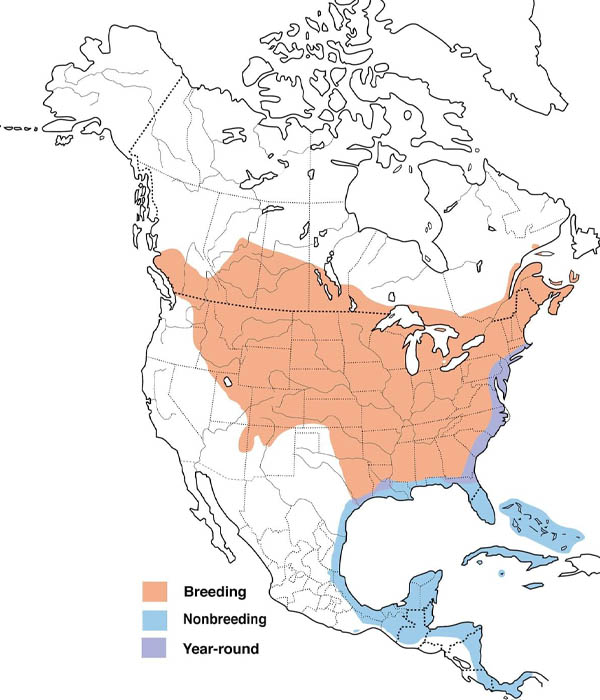
35. Red-breasted Nuthatch (13% Frequency)
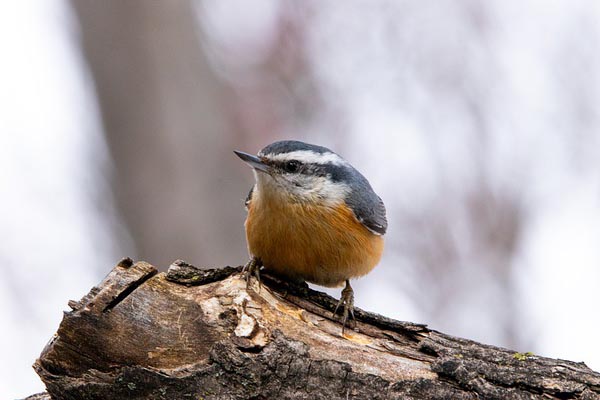
The Red-breasted Nuthatch is another common bird found in Maine at a 13% frequency of occurrence. These are small birds that grow at a length of 4.3 inches and weigh around 0.3 to 0.5 ounces.
These birds almost look similar to white-breasted nuthatches. As their name implies, the significant difference between the two is that these nuthatches have a red-orange-colored chest. Their upper parts are blue-gray, and they also have a white-colored stripe on their cheeks and the top of their eyes.
Male and female Red-breasted Nuthatches look similar. However, females look paler than male birds.
Red-breasted Nuthatches are present all year round in Maine. Some populations may move south for winter, but it’s very irruptive.
Unlike nuthatches in the west, eastern Red-breasted nuthatches prefer living in deciduous forests rather than in coniferous forests. But during winter, they can be present in various habitats like orchards, parks, plantations, shaded trees, and even backyards.
These birds eat lots of insects, so if you wish to attract them, you may want to make your backyard more insect-friendly. You can also offer them sunflower seeds, peanuts, and suet.
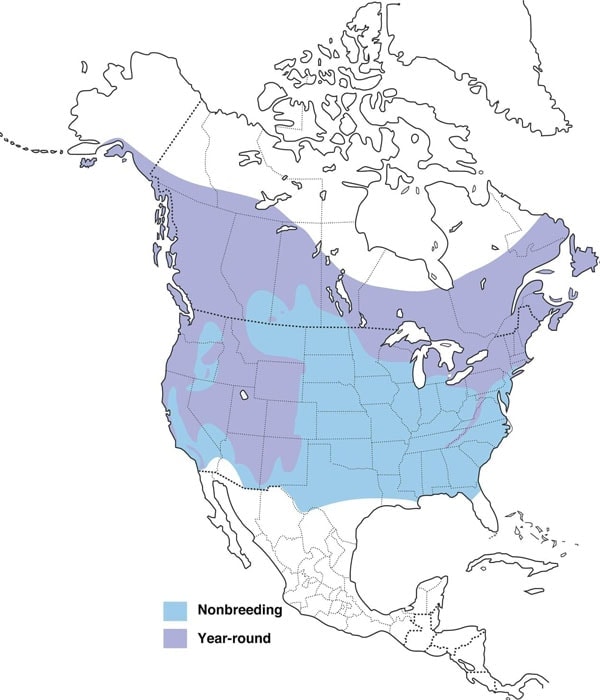
36. Mallard Duck (13% Frequency)
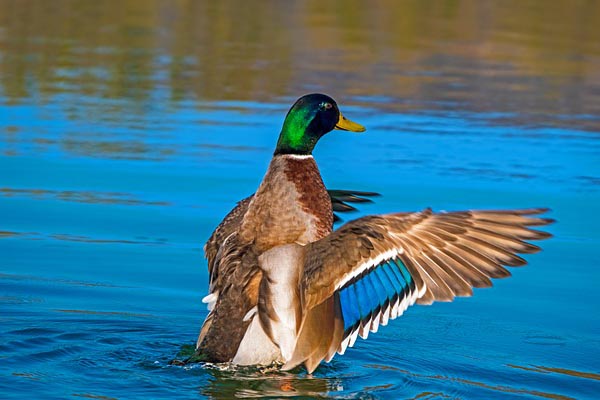
Next, also at 13% frequency of occurrence, we have the Mallard Duck or the Mallard.
Populations of these ducks in Maine are only found during the breeding season. They are medium-distance migrants, so they often move to the southern states for winter.
These birds are large and grow at a length of 19.7 to 25.6 inches. Male Mallards are very colorful with their iridescent-green heads, yellow bill, gray bodies, black rear, and brown breasts. Females, on the other hand, are mottled brown all over.
Mallards are found in any wet habitats, including lakes, ponds, city parks, marshes, and even farms. There is a great chance that when you were feeding some ducks at your nearby park, you’ve already encountered some Mallards.
These birds eat various food, which may sometimes include insects, freshwater shrimp, and some seeds.
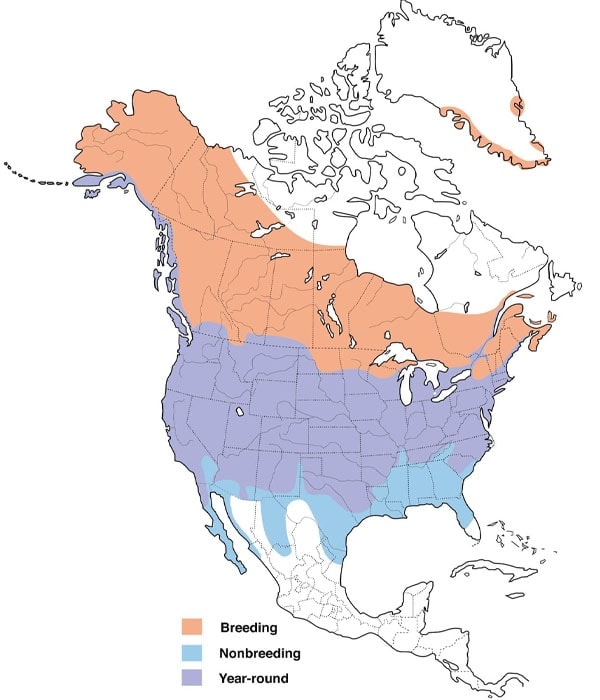
37. Turkey Vulture (13% Frequency)
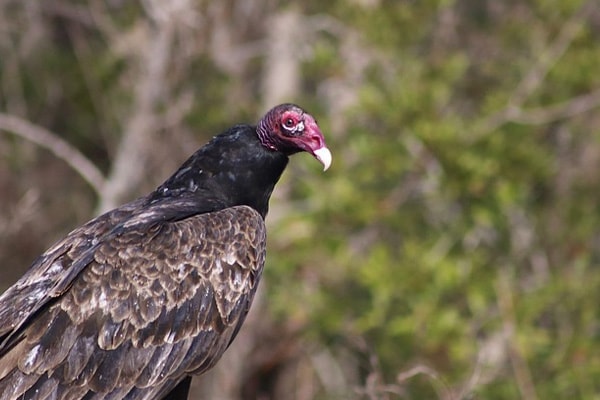
Next, we have another raptor on this list, the Turkey Vulture, which is at a 13% frequency of occurrence.
These large birds grow at a length of 25.2 to 31.9 inches and weigh around 70.5 ounces. These birds may appear all black from a distance, but up close, you’ll notice that they’re really dark brown in color with featherless redheads.
You’ll often find these birds in roadsides and landfills. And they often fly around open areas from mixed farmlands to forests in search of food, including other birds, amphibians, invertebrates, and fish. But their favorite of all is freshly dead animals.
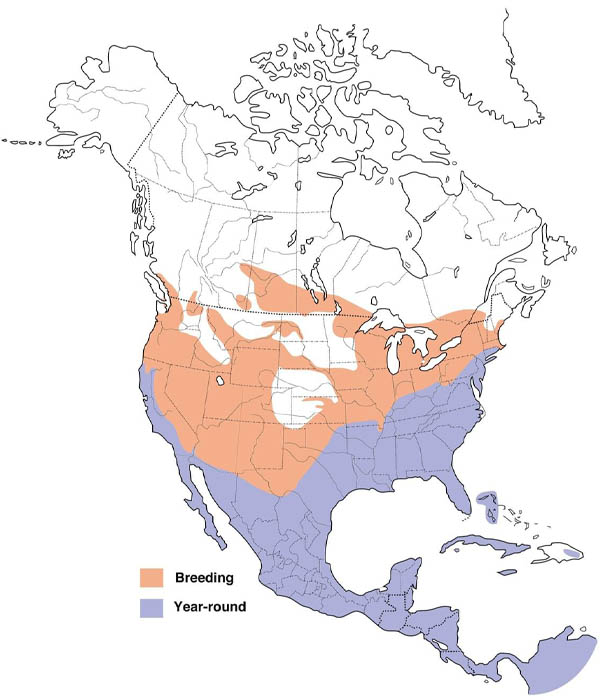
38. House Finch (12% Frequency)

The House Finch is a small bird found all year round in all parts of Maine, except for the northern areas. They occur in backyards at 12% frequency.
These are small birds that only grow at a length of 5.1 to 5.5 inches and weigh around 0.6 to 0.9 inches. They are pretty colorful, featuring a rosy red face and upper breast areas with a brown back, lower belly, and tail. Females appear different from males, with their plain grayish-brown color.
As their name implies, House Finches are commonly found near people. You can see them around human-made structures like buildings, parks, lawns, and urban centers. In rural areas, the birds are also commonly seen in barns and stables.
They are frequent visitors of bird feeders. And thanks to their natural inquisitive behavior, they are usually the first birds to discover new feeders.
Most bird watchers would actually say that if you want to attract many birds, you need to attract the House Finches first. These birds love sunflower seeds, safflower seeds, and nyjer seeds, so make sure to fill up your bird feeders with those.
You can also grow some fruit-bearing plants like blackberries, figs, cherries, peaches, strawberries, and plums.
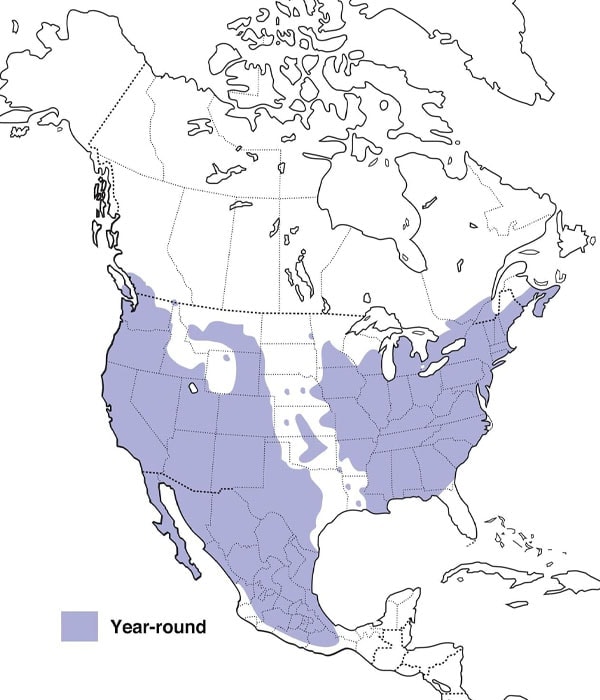
39. Barred Owl (12% Frequency)

Also at 12% frequency is the Barred Owl, famous for its motherly call “Who cooks for you”. Don’t believe me? Try to watch the video below:
These large birds grow at a length of 16.9 to 19.7 inches and weigh around 16.6 to 37.0 ounces. They feature a brown and white mottled pattern all over their bodies. Their eyes brown, and their wings and tails show brown and white bar patterns, as their name implies.
Barred Owls are resident birds. They are found all year round in Maine, usually in forests with very large trees and near a water source. They also eat various animals, including squirrels, mice, rabbits, chipmunks, and even birds.
Like many owls, this species is nocturnal, which means they rest during the day and hunt at night. So, you’ll most likely not see them flying into your backyard during the day. But, you might hear them at night.
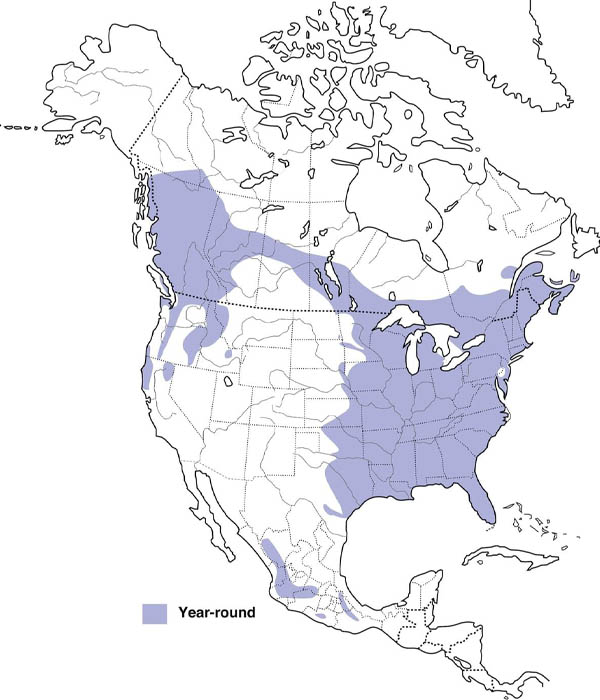
40. Yellow-Bellied Sapsucker (12% Frequency)
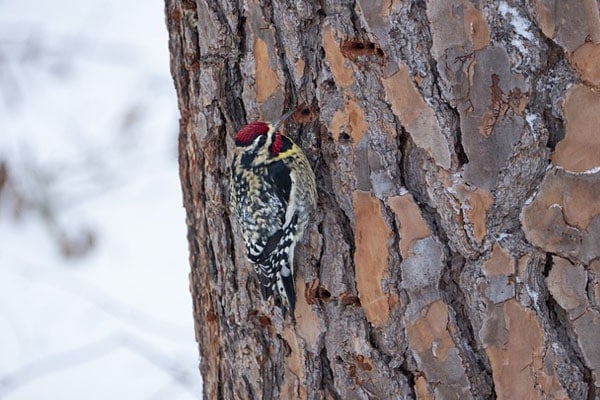
Last but not least, we have the Yellow-bellied Sapsucker that also appears in backyards at 12% frequency.
They are a type of woodpecker that grows at a length of 7.1 to 8.7 inches and weigh around 1.5 to 1.9 ounces. So, they are larger than the Downies but slightly smaller than the Hairy Woodpeckers.
The birds are mostly a combination of black and white colors with a distinct red forehead. They feature a black stripe across their eyes, a white stripe along their folded wing, and some yellowish marks on their bellies.
Male and female birds almost look the same, except for the fact that males also have red throats.
These are short to long-distance migratory birds. They are mainly found in Maine throughout the breeding season, and they move further down to the southeastern parts of the US and Mexico.
These birds breed in young forests, usually along the edges. As their name implies, these birds mainly feed on “sap,” so they take advantage of ripe trees for feeding, unlike other woodpeckers who would prefer dead trees.
Yellow-bellied Sapsuckers also occasionally feed on insects and share a common behavior with flycatchers with their ability to catch insects midair.
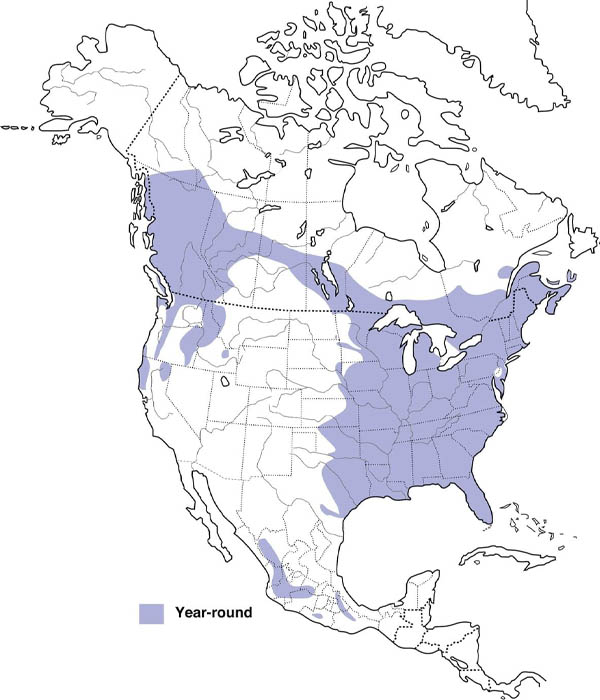
Final Thoughts On 40 Most Common Backyard Birds in Maine
And those are the 40 most common backyard birds in Maine!
They are all beautiful, right? And there’s more than you can find! Unfortunately, I couldn’t include all species.
What do you think about this list? Have you seen every bird on this list already?
All bird migration map images are provided allaboutbirds.org
The post Top 40 Backyard Birds Of Maine appeared first on BirdInformer.com.
from BirdInformer.com https://ift.tt/3xAaCdy

No comments:
Post a Comment